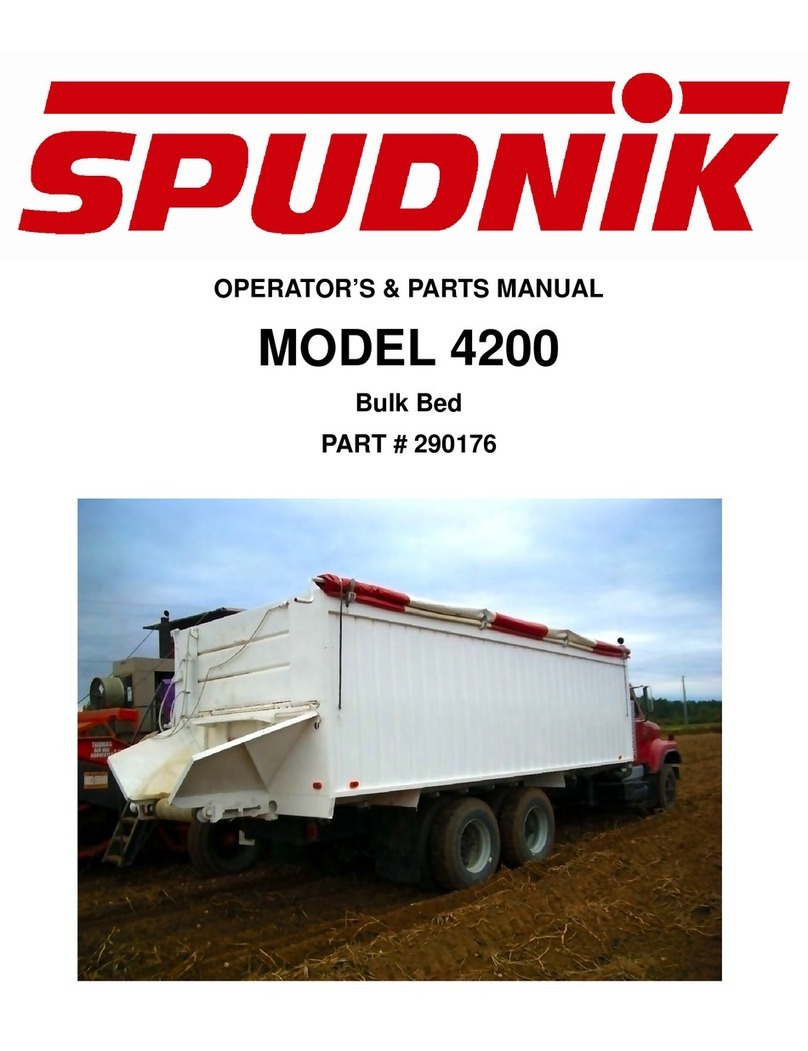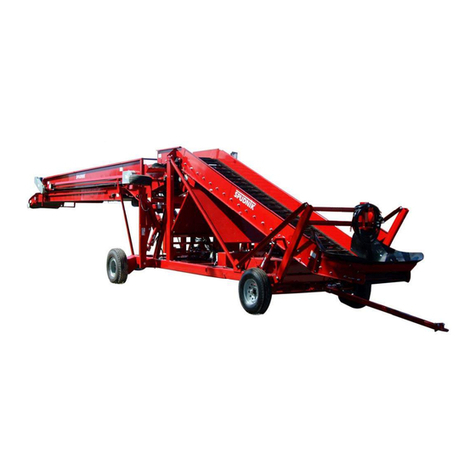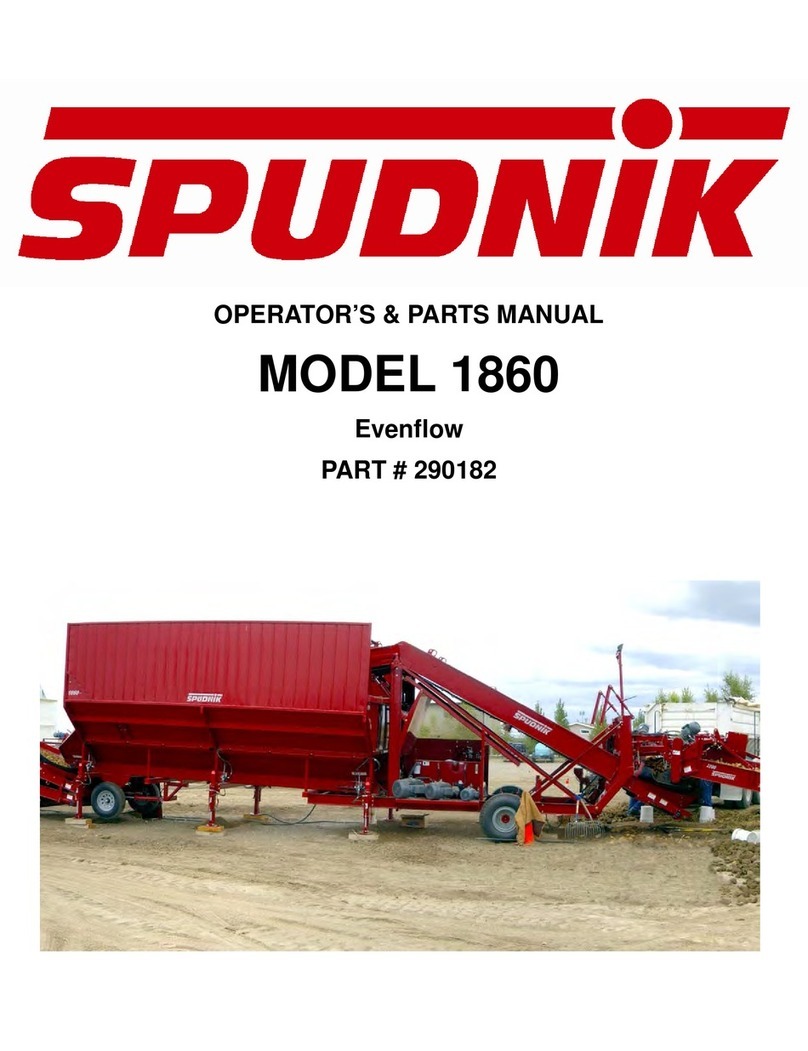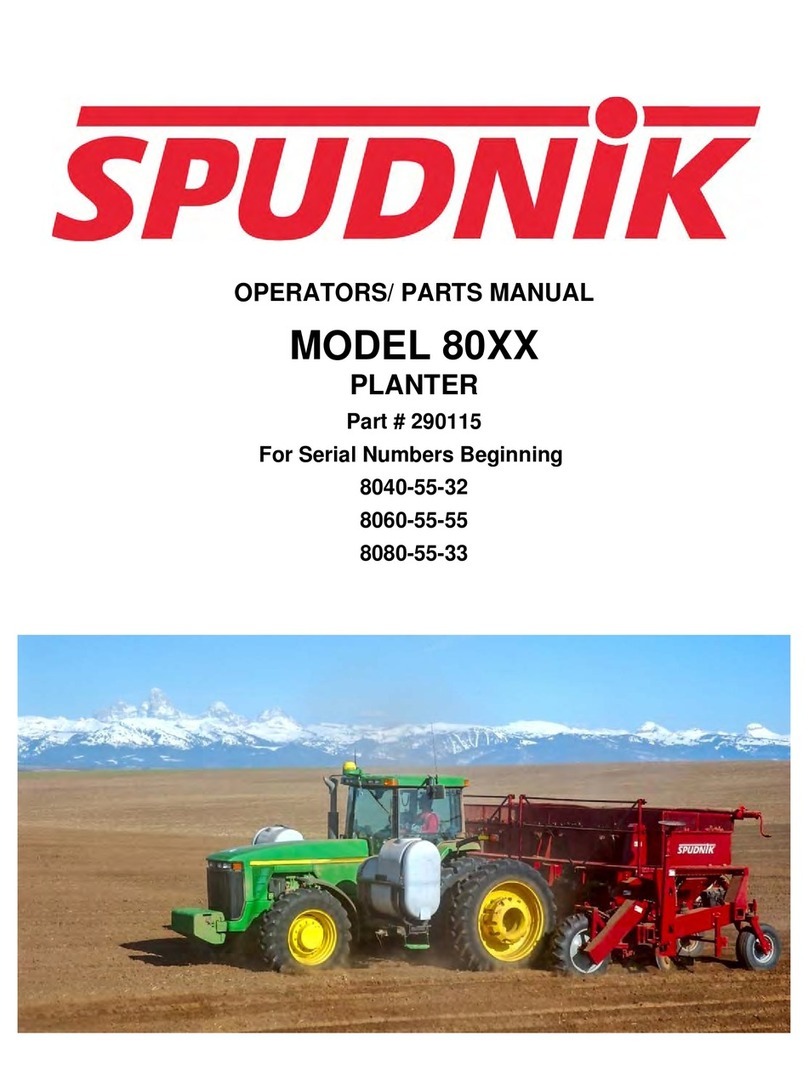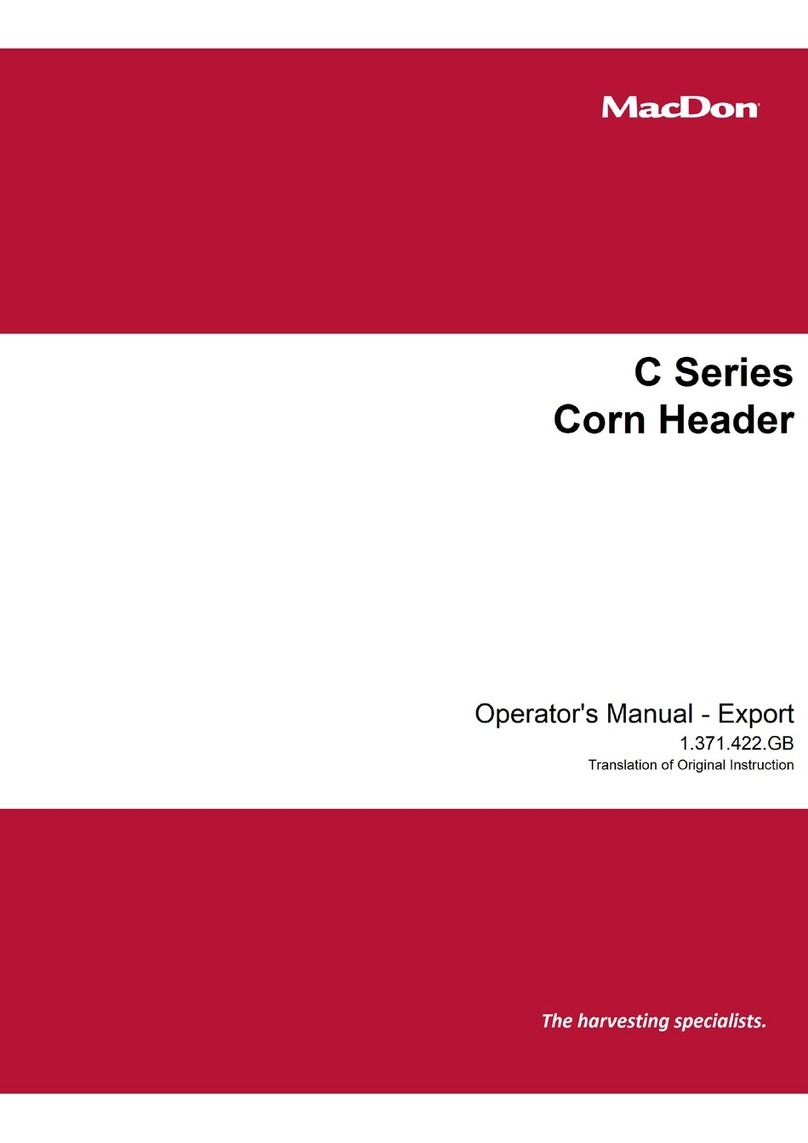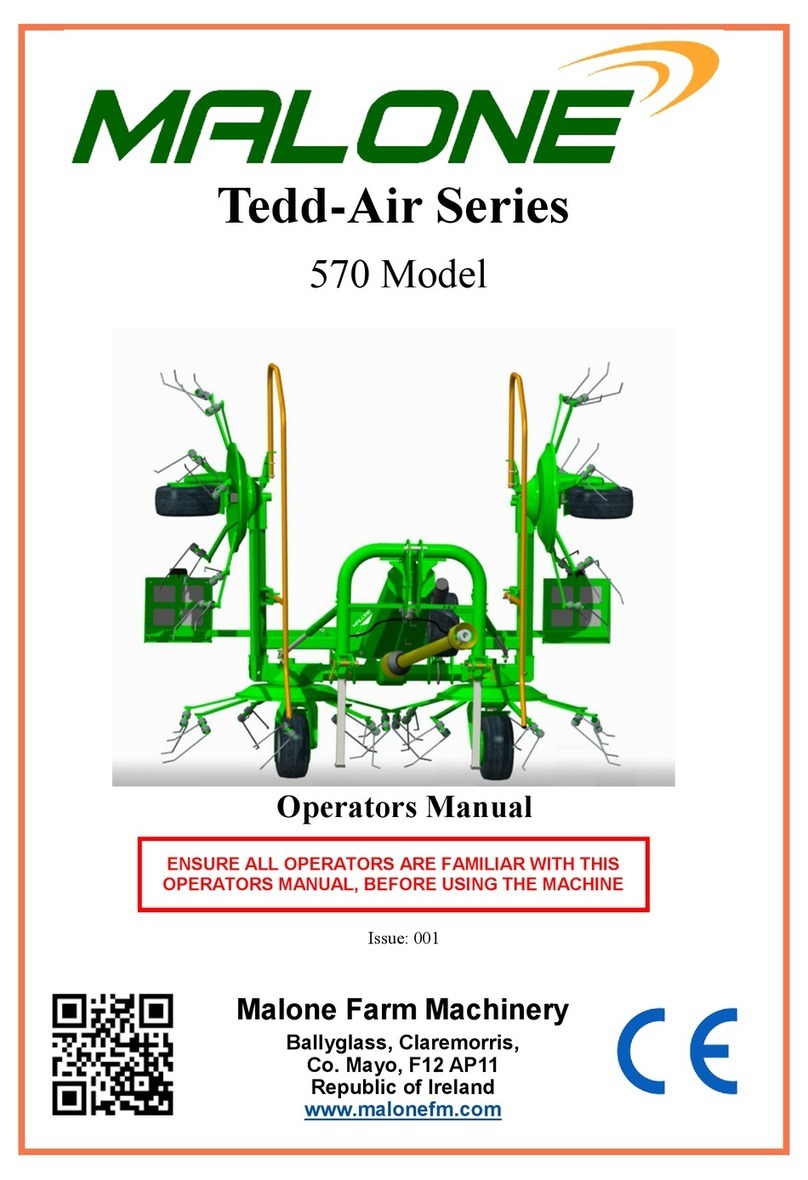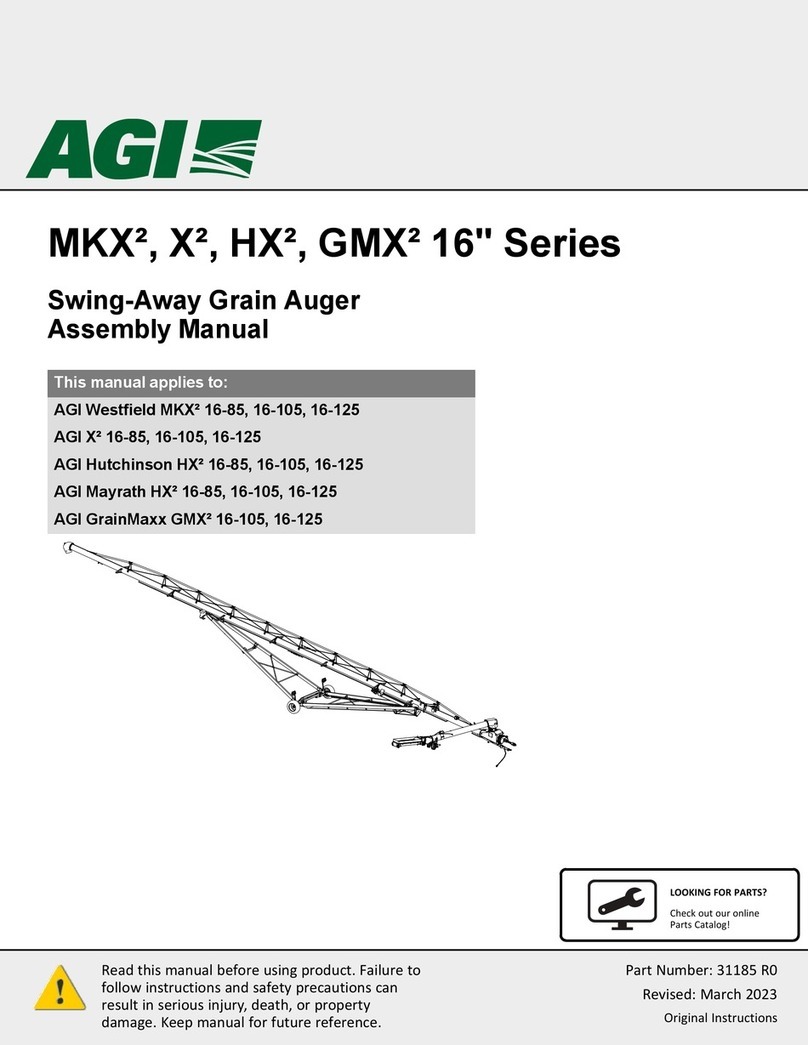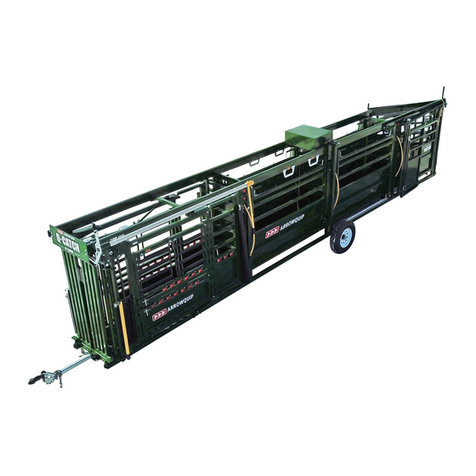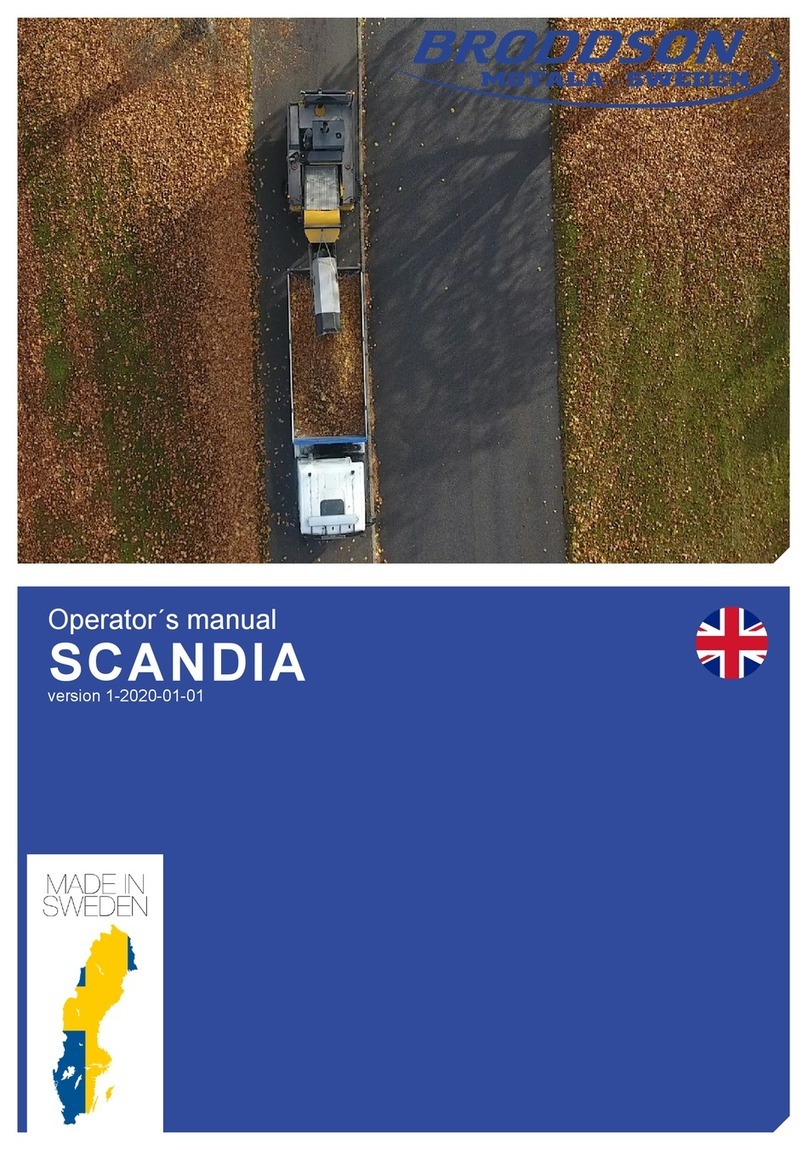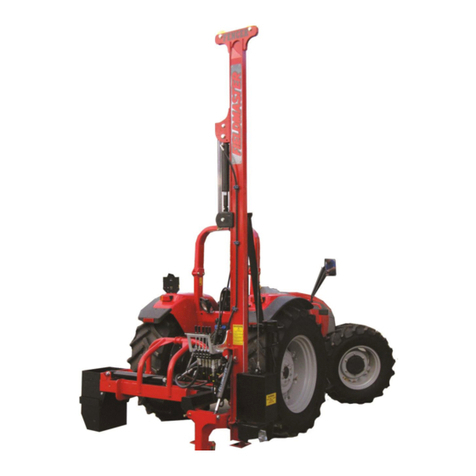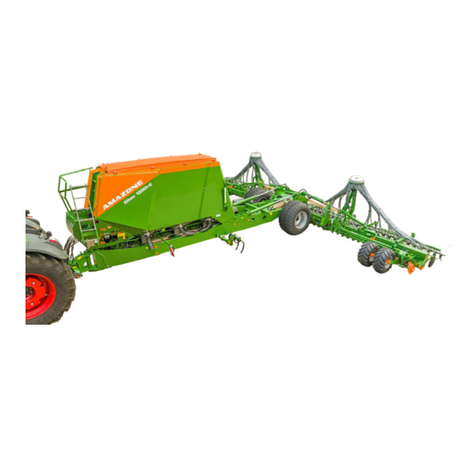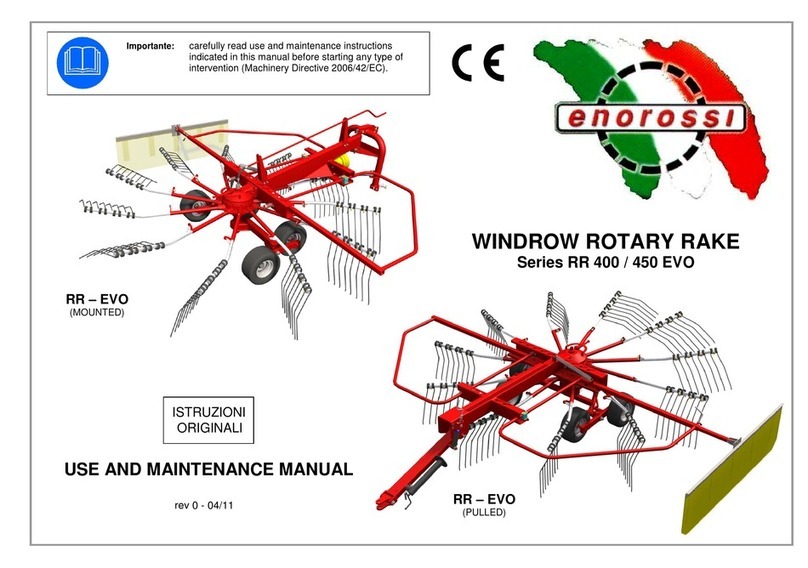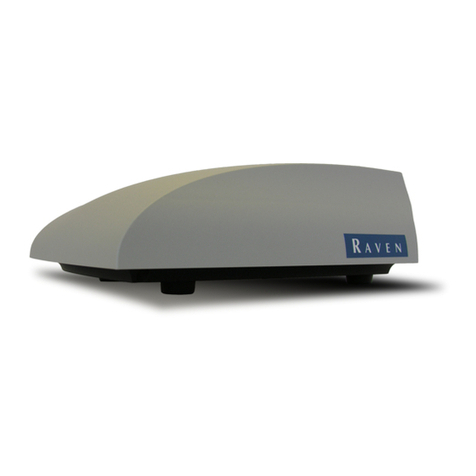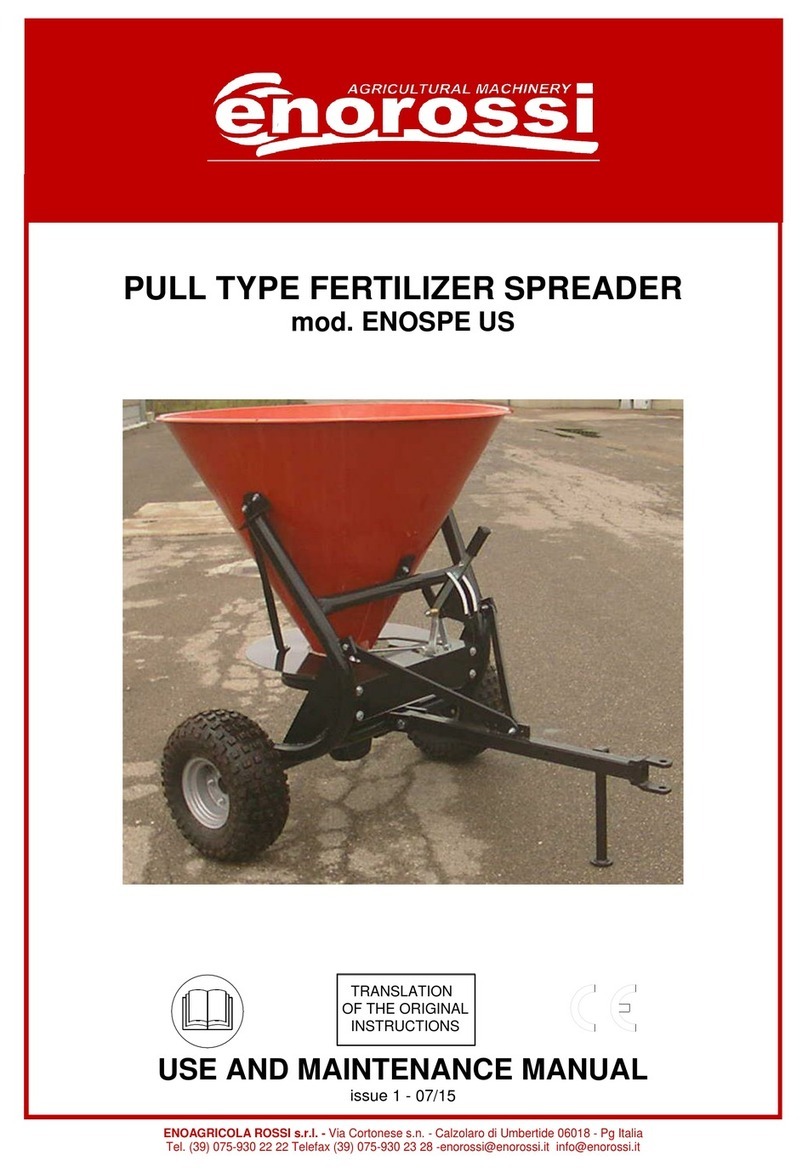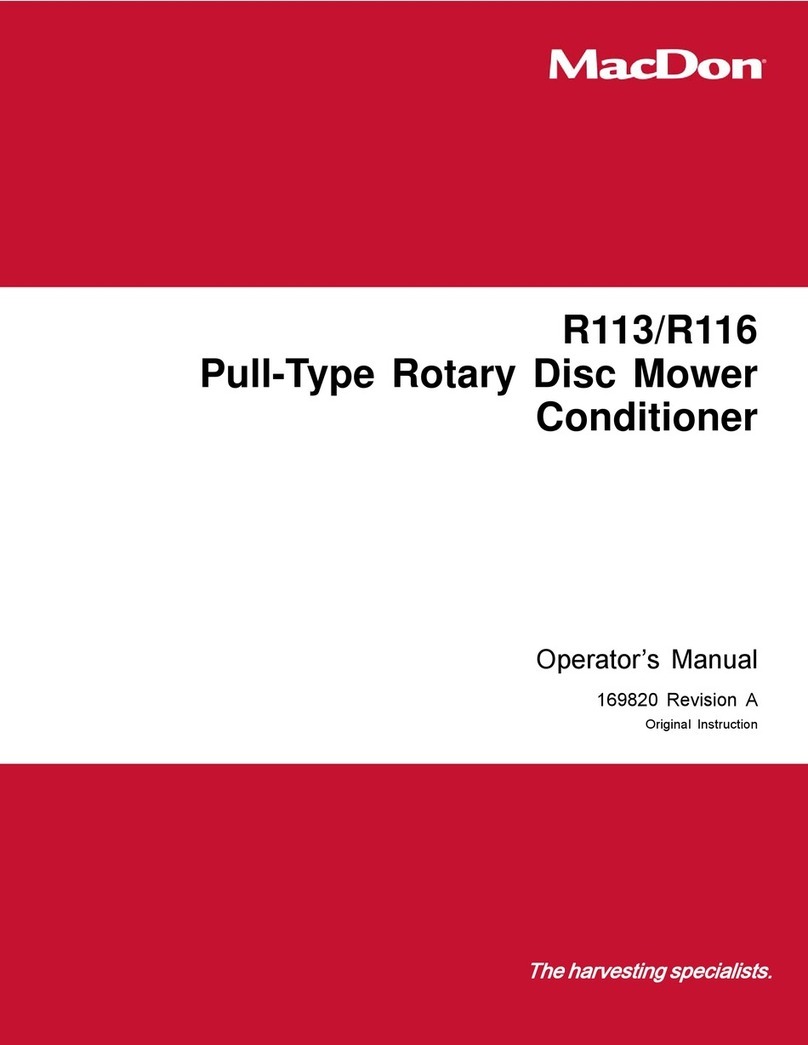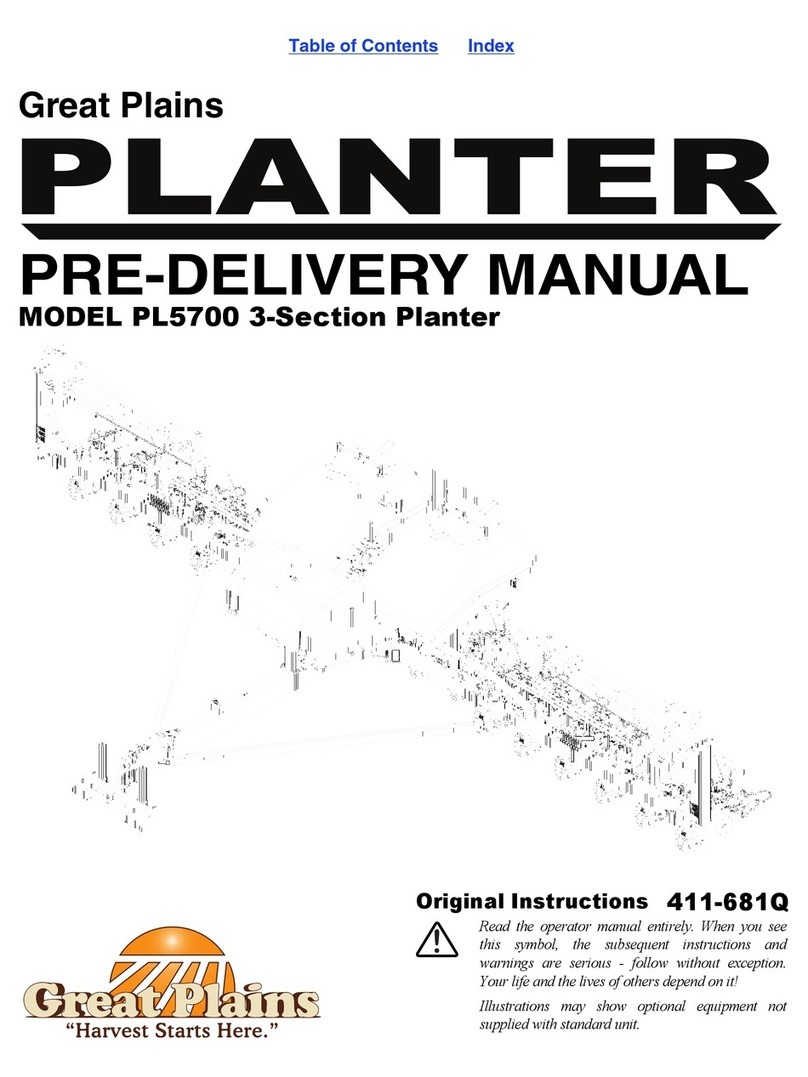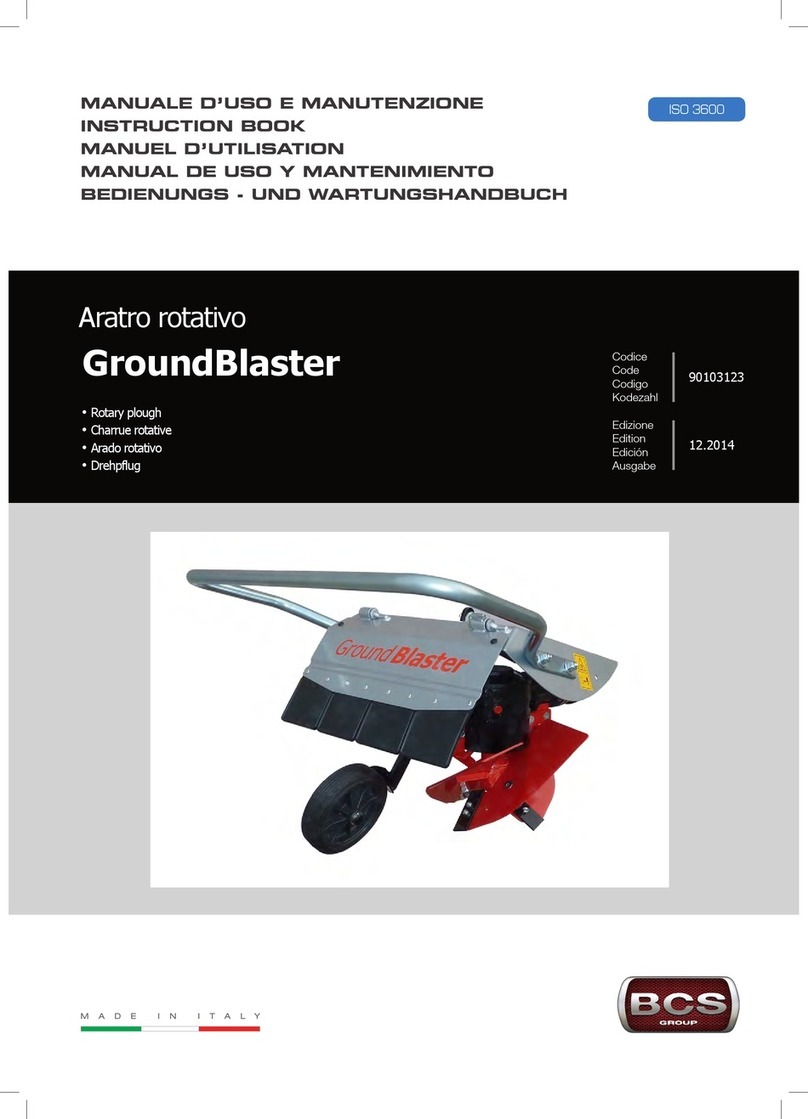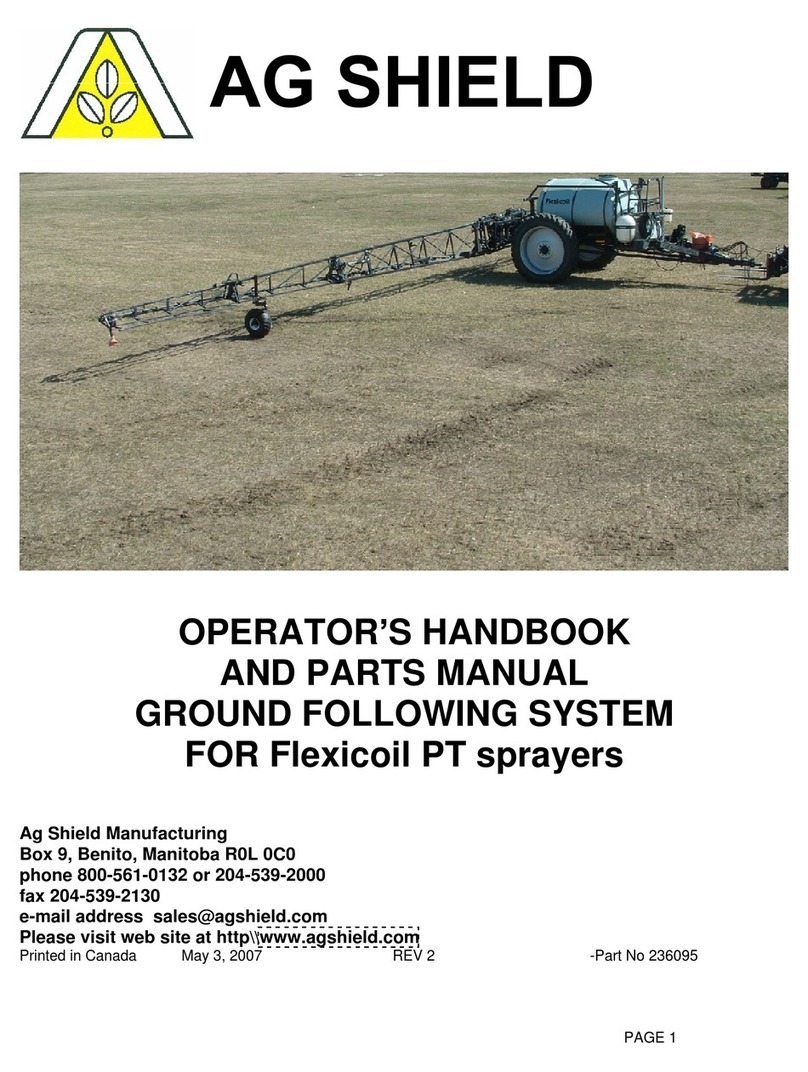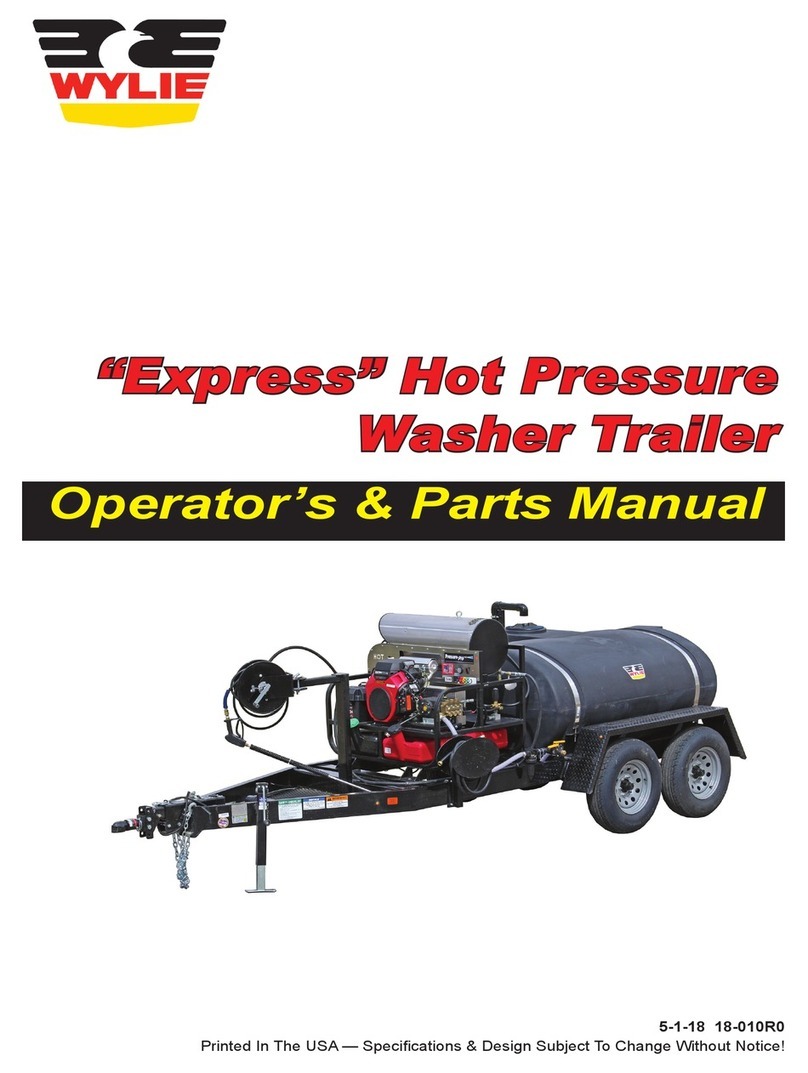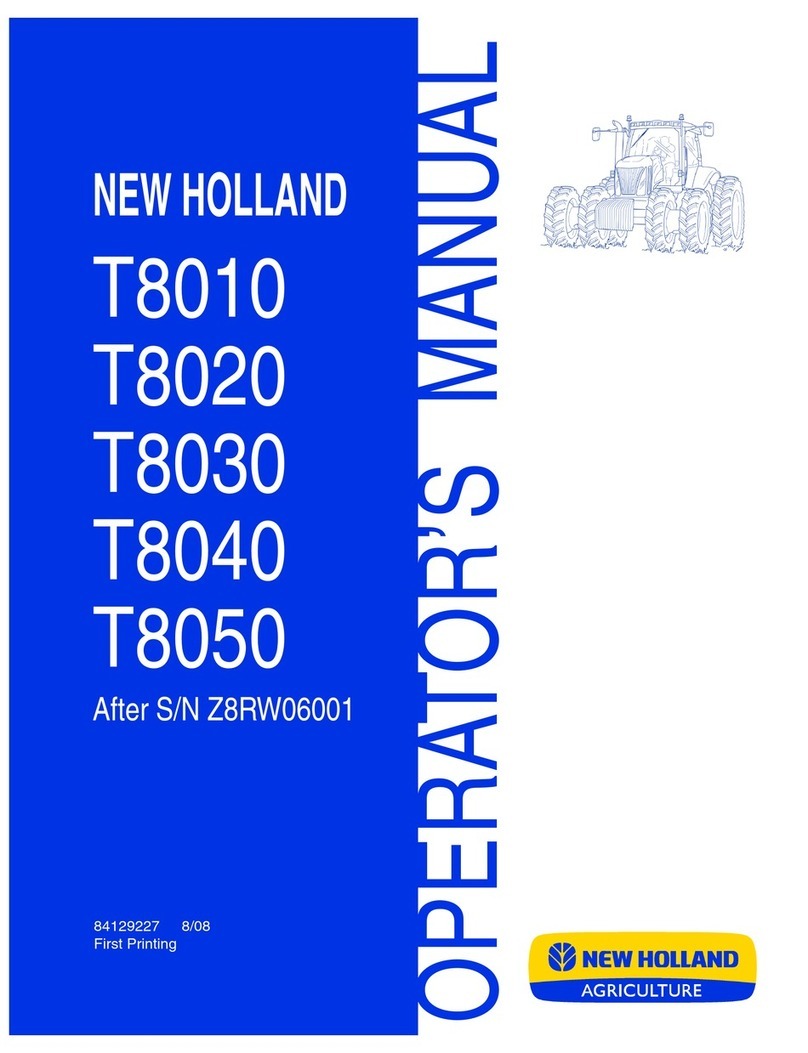Spudnik AIRSEP 992 Owner's manual

OWNER / OPERATOR MANUAL
Original Instructions
992 AirSep Eliminator
SERIAL #992-55-69 through 72
Part #: 290449
Revision: 22, Mar. 2022


i
We constantly strive to provide solutions
to make our customers so successful
that they praise our revolutionary innovation,
unmatched customer service,
and quality that is second to none.
Spudnik®, SimpleSep™, MultiSep™, Star Table™, AirSep®, Terra Float™, are trademarks of Spudnik Equipment
Company LLC. John Deere, Case, IH, Case-IH,CAT, Challenger, GreenStar, are trademarks of theirrespective trademark
owners.
Copyright © 2020 by Spudnik Equipment Company LLC. All rights reserved.
Corporate Headquarters
584 West 100 North
P.O. Box 1045
Blackfoot, ID 83221
Phone: (208) 785-0480
E-Mail: spudnik@spudnik.com
Web Site: www.spudnik.com
BLACKFOOT, ID
584 West 100 North
Blackfoot, ID 83221
Phone (208) 785-0480
Fax (208) 785-1497
HEYBURN, ID
300 Centennial Dr.
Heyburn, ID 83336
Phone (208) 436-8052
Fax (208) 495-9170
GRAFTON, ND
1410 12th St. West
Grafton, ND 58273
Phone (701) 352-9603
Fax (701) 352-9610
PRESQUE ISLE, ME
80B Airport Drive
Presque Isle, ME
Phone (207) 764-4686
Fax (207) 764-4674
Service Centers

ii
OWNER/OPERATOR MANUAL
992
A
IR
S
EP
E
LIMINATOR
Table of Contents
Introduction ..........................................................................................................................................................................vi
Understanding Information Signal Words.............................................................................................................................vi
Foreword.............................................................................................................................................................................vii
Limited Warranty Policy for New Spudnik Machinery......................................................................................................... viii
General ................................................................................................................................................................................ix
Declaration of Conformity......................................................................................................................................................x
Product Characteristics........................................................................................................................................................xi
1. Safety.......................................................................................................................................................................1
1.1. Recognize Safety Information..............................................................................................................................1
1.2. Understanding Safety Signal Words....................................................................................................................1
1.3. Exemption From Liability......................................................................................................................................1
1.4. General Guidelines..............................................................................................................................................1
1.5. Identification of Training Requirements ...............................................................................................................2
1.6. Accident Prevention Guide & Regulations...........................................................................................................2
1.7. Risks of Ignoring Accident Prevention.................................................................................................................3
1.8. Connecting a Tractor to the Machine...................................................................................................................3
1.9. Connecting Machine PTO....................................................................................................................................4
1.10. Connecting Machine Hydraulics ..........................................................................................................................4
1.11. Operating Safety Practices..................................................................................................................................4
1.12. Transporting/Towing Safety Practices.................................................................................................................6
1.13. Electrical System and Electronics........................................................................................................................6
1.14. Hydraulic Systems...............................................................................................................................................7
1.15. Machine Storage..................................................................................................................................................7
1.16. Maintenance and Inspection Guidelines..............................................................................................................8
1.17. Acknowledgement Signature.............................................................................................................................10
2. Machine Overview..................................................................................................................................................11
2.1. Method of Operation..........................................................................................................................................11
2.2. Machine Specifications......................................................................................................................................12
2.3. Tire Specifications .............................................................................................................................................12
2.4. Machine Component Identification and Location...............................................................................................13
2.5. Safety and Information Labels...........................................................................................................................14
2.6. Label Identification and Part Number.................................................................................................................14
2.7. Installing Replacement Labels...........................................................................................................................22
2.8. Label Locations..................................................................................................................................................23
3. Site Selection and Set Up......................................................................................................................................26
3.1. Site Selection.....................................................................................................................................................26
3.2. Set Up................................................................................................................................................................26
3.2.1. Level the Eliminator.......................................................................................................................................26
3.2.2. Check oil level in the Hydraulic Oil Reservoir................................................................................................27

iii
OWNER/OPERATOR MANUAL
992 AIRSEP ELIMINATOR
3.2.3. Install Rock Conveyor Discharge Shield. ......................................................................................................28
3.3. Connect to power ..............................................................................................................................................28
3.4. Connect interfacing conveyors, pilers, etc.........................................................................................................31
4. Operational Controls..............................................................................................................................................31
4.1. VFD Panel.........................................................................................................................................................31
4.2. Control Panel.....................................................................................................................................................31
4.3. Hydraulic Control Valves ...................................................................................................................................34
5. Operation and Adjustment.....................................................................................................................................37
5.1. Theory of Operation...........................................................................................................................................37
5.2. Startup/Shutdown Sequence Checklists............................................................................................................40
5.2.1. Full startup when Hydraulic Control Valves are set to off..............................................................................40
5.2.2. Abbreviated startup when Hydraulic Control Valves are set to operate.........................................................41
5.2.3. Shutdown with Hydraulic Control Valves set to off........................................................................................41
5.2.4. Shutdown with Hydraulic Control Valves set to operate................................................................................42
5.3. Mechanical Adjustments....................................................................................................................................43
5.3.1. Leveling Jacks...............................................................................................................................................43
5.3.2. Elevator height. .............................................................................................................................................43
5.3.3. Elevator Belt..................................................................................................................................................45
5.3.4. Elevator Alignment Rollers............................................................................................................................48
5.3.5. Transfer Roller...............................................................................................................................................49
5.3.6. Transfer Roller Scraper.................................................................................................................................49
5.3.7. Blower Motor Jackshaft Drive Belt tension adjustment..................................................................................51
5.3.8. Blower Drive Belt tension adjustment............................................................................................................51
5.3.9. Blower Fan Speed Sensor. ...........................................................................................................................53
5.3.10. Grid Shaker...............................................................................................................................................54
5.3.11. Rock Conveyor. ........................................................................................................................................56
5.3.12. Trash Conveyor height..............................................................................................................................57
5.3.13. Cross Conveyor angle. .............................................................................................................................59
5.3.14. Cross Conveyor left/right discharge..........................................................................................................60
5.3.15. Extending the Cross Conveyor. ................................................................................................................61
5.3.16. Cross Conveyor Belt tension & alignment.................................................................................................62
5.4. Electrical Adjustments .......................................................................................................................................64
5.4.1. Blower Fan ON/OFF......................................................................................................................................64
5.4.2. Blower Fan speed. ........................................................................................................................................65
5.4.3. Programming Blower Fan minimum operating speed setpoint......................................................................66
5.4.4. Programming Rock Gate close setpoint........................................................................................................67
5.4.5. Emergency Stop............................................................................................................................................67
5.4.6. Emergency Stop recovery.............................................................................................................................68
5.4.7. Hydraulic Pump ON/OFF ..............................................................................................................................68
5.5. Hydraulic Adjustments.......................................................................................................................................69
5.5.1. Rock Gate open/close...................................................................................................................................69

iv
OWNER/OPERATOR MANUAL
992
A
IR
S
EP
E
LIMINATOR
5.5.2. Grid Shaker drive...........................................................................................................................................70
5.5.3. Rock Conveyor drive.....................................................................................................................................70
5.5.4. Discharge (Cross) Conveyor drive. ...............................................................................................................71
5.5.5. Elevator/Trash Conveyor drive......................................................................................................................72
6. Towing on Roads...................................................................................................................................................73
6.1. Preparing for Transport......................................................................................................................................73
6.1.1. Disconnect interfacing conveyors, pilers, etc.................................................................................................73
6.1.2. Disconnect power..........................................................................................................................................73
6.1.3. Position Cross Conveyor for transport...........................................................................................................73
6.1.4. Remove Rock Conveyor Discharge Shield....................................................................................................74
6.1.5. Retract Leveling Jacks. .................................................................................................................................74
6.1.6. Retrieve and install the Tongue.....................................................................................................................75
6.1.7. Pre-towing requirements. ..............................................................................................................................75
6.2. Transporting the Eliminator................................................................................................................................77
7. Maintenance & Service..........................................................................................................................................77
7.1. Cleaning & Debris Removal...............................................................................................................................77
7.1.2. Removal of debris around the Blower Fan Motor..........................................................................................77
7.1.3. Removal of debris from the Air Chamber. .....................................................................................................78
7.2. Lubrication & Oil ................................................................................................................................................81
7.2.1. Grease fittings for bearings, pivot points, and U-joints. .................................................................................81
7.2.2. Repack Wheel Hubs......................................................................................................................................85
7.2.3. Roller chains..................................................................................................................................................85
7.2.4. Hydraulic oil level...........................................................................................................................................86
7.2.5. Filling Hydraulic Oil Reservoir. ......................................................................................................................86
7.3. Inspection & Repair ...........................................................................................................................................87
7.3.1. Roller chains & sprockets..............................................................................................................................87
7.3.2. Belts & sheaves.............................................................................................................................................89
7.3.3. Blower Motor Jackshaft Drive Belt replacement............................................................................................91
7.3.4. Blower Drive Belt replacement......................................................................................................................93
7.3.5. Hydraulic hoses/fittings/cylinders. .................................................................................................................94
7.3.6. Changing hydraulic oil...................................................................................................................................95
7.3.7. Replacing hydraulic oil filter element.............................................................................................................95
7.3.8. Rollers...........................................................................................................................................................96
7.3.9. Conveyor belts. .............................................................................................................................................97
7.3.10. Belted chains. ...........................................................................................................................................97
7.3.11. Tires & wheels. .......................................................................................................................................103
7.3.12. Sensors...................................................................................................................................................104
7.3.13. Special Tools. .........................................................................................................................................105
8. Cleaning & Storage..............................................................................................................................................106
8.1. Cleaning for Storage........................................................................................................................................106

v
OWNER/OPERATOR MANUAL
992 AIRSEP ELIMINATOR
8.2. Storage............................................................................................................................................................107
8.2.2. Removing from storage...............................................................................................................................107
9. Troubleshooting...................................................................................................................................................109
9.1. Eliminator Operation/Optimization...................................................................................................................109
9.2. Electrical/Controls............................................................................................................................................110
9.3. Hydraulic/Controls...........................................................................................................................................111
9.4. Mechanical ......................................................................................................................................................112
10. Miscellaneous Specifications & Reference ..........................................................................................................113
10.1. Fastener Torque Guidelines............................................................................................................................113
10.2. Shear Pin Guidelines.......................................................................................................................................114
10.3. Hydraulic Fittings Guidelines ...........................................................................................................................114
10.4. Lubricant Specifications...................................................................................................................................116
10.4.1. Fluids and lubricants...............................................................................................................................116
10.4.2. Storing lubricants....................................................................................................................................116

vi
OWNER/OPERATOR MANUAL
992
A
IR
S
EP
E
LIMINATOR
Introduction
Welcome to the Spudnik line of potato handling equipment. We appreciate your decision to make our equipment a part of
your operation, and look forward to a long term partnership. We strive to put the best quality and workmanship into each
of our machines, and hope as you use your Spudnik Eliminator that you will find this to be true. This manual has been
prepared to aid you in the safe operation and servicing of your machine.
Read this manual carefully to learn how to operate your machine safely, efficiently, and within the design limits of the
machine. Failure to operate the machine as instructed could result in personal injury and/or damage to the machine.
This manual is considered to be an important part of the machine. Keep the manual in the storage container provided so it
is always available for reference and to document the training of new operators. This manual should be transferred to the
new owner if the machine is sold.
Warranty is provided, as part of the Spudnik Equipment Company LLC service program, for customers who operate and
maintain their equipment as outlined in this manual. See page viii for the Warranty Policy.
Understanding Information Signal Words
IMPORTANT and NOTE are signal words which accompany messages which do not involve safety issues. The
appropriate signal word for each message has been chosen according to the following guidelines.
IMPORTANT: Indicates situations or practices that may result in machine damage. Also provides instruction
that must be followed to ensure proper operation or installation of the equipment.
NOTE: Emphasizes useful tips, recommendations, and information to assist the operator and ensure smooth
and efficient operation.
Examples of the format used for informational messages are shown below.
IMPORTANT: This is an example of an important message notice.
NOTE: This is an example of a note message.

vii
OWNER/OPERATOR MANUAL
992 AIRSEP ELIMINATOR
Foreword
This manual is intended to familiarize the user with the Spudnik 992 AirSep Eliminator and its designated use.
This manual contains important information on how to operate the machine safely, properly, and efficiently. Observing the
instructions in this manual helps avoid dangers, reduce repair costs and down-time, and increases the reliability and
service life of the machine.
This manual includes by reference all relevant local and national rules and regulations concerning accident prevention
and environmental protection. In addition to country or regional rules and regulations, the generally recognized technical
rules for safe and proper use/operation are included by reference and must be observed. When transporting this machine
on roadways, all traffic regulations must be observed.
This manual must be available whenever the machine is in use.
This manual must be read and applied by all persons involved with the machine, such as:
•Operation: including setting up, normal operation, troubleshooting during operations, and disposal of consumables.
•Maintenance: including servicing, inspection, and repair.
•Transport: including loading/unloading onto transport vehicle, towing, and operational movement.
Insert new Figure.
Figure 1
The Owner/Operator manual is stored inside case.

viii
OWNER/OPERATOR MANUAL
992
A
IR
S
EP
E
LIMINATOR
Limited Warranty Policy for New Spudnik Machinery
On the terms and conditions set forth herein, Spudnik Equipment Company LLC (“Spudnik”) warrants to the original
purchaser of each new Spudnik machine that the machine is free from defects in material and workmanship. Spudnik will
repair or replace, at its option, any part covered by this warranty that is found to be defective during the warranty period
outlined below. Warranty service must be performed by an authorized dealer or representative of Spudnik. This warranty
is applicable only for the normal service life expectancy of the product or components, as noted in the following table.
Once the warranty period has begun, it cannot be suspended, interrupted, or extended.
What is included in the Spudnik Warranty:
Those items that are excluded from this warranty are as follows:
(1) Any merchandise or components thereof, which, in the opinion of the company have been subject to: (a) Rock chip
damage and other abuse to painted surfaces, (b) Damage caused by weather (including UV damage), accident, or acts of
God, (c) Any product that has been altered or modified in ways not approved by Spudnik, (d) Depreciation or damage
caused by normal wear, lack of reasonable and proper maintenance, misuse, failure to follow the product’s Operator
Manual recommendations, (e) Using machine for other than normal moving of agricultural products during planting,
harvest, and processing seasons. Agricultural products to include: Potatoes, beets, onions, carrots, grains, etc. (2) Used
products. (3) Repairs made by unauthorized dealers.
To Obtain Warranty Service
To be eligible for the Spudnik warranty, purchaser must: (a) Have already remitted payment in full (b) When purchased by
an authorized dealer, have entered the delivery declaration into the Spudnik warranty website tools.spudnik.com, (c)
Report the product defect to an authorized dealer or Spudnik sales representative and request repair within 30 days of
noticing the defect, (d) Repair or replace failed parts immediately upon failure to prevent additional damage (e) Make the
product and/or failed parts available to the dealer or service center within 90 days following submittal of claim,
transportation/shipping charges prepaid.
The selling dealer has no authority to make any representation or promise on behalf of Spudnik, or to modify the terms or
limitations of this warranty in any way.
Limited Warranty Statement
Except as expressly stated herein, to the full extent permitted by law, Spudnik disclaims any and all warranties,
representations, and promises, express or implied, as to the quality, performance, or freedom from defect of any Spudnik
new machinery. NO IMPLIED WARRANTY OF MERCHANTABILITY OR FITNESS IS MADE. IN NO EVENT WILL
SPUDNIK, AN AUTHORIZED SPUDNIK DEALER, OR ANY COMPANY AFFILIATED WITH SPUDNIK BE LIABLE FOR
INCIDENTAL OR CONSEQUENTIAL DAMAGES. This warranty is subject to any existing conditions of supply which may
directly affect Spudnik’s ability to obtain materials or manufacture replacement parts. Spudnik reserves the right to make
improvements in design or changes in specifications at any time, without incurring any obligation to owners of units
previously sold. No one is authorized to alter, modify or enlarge this warranty nor the exclusion, limitations, and
reservations set forth herein. This limited warranty policy supersedes and replaces all other policies pertaining to
warranty.
To obtain more information please contact your dealer, or Spudnik at 1-208-785-0480.
Product
Warranty Term
Rollers, Sprockets, Roller Chain, Belt Lacing, and Bearings.
180 Days from 1st day of operation or 250 Hours of
machine operation, whichever comes first.
All paint to include: Insufficient coverage, failure of paint
adherence, and excessive runs. NOTE: Runs are excessive if
they exceed more than 15% of the painted surface on the
machine.
12 Months from date of delivery of new Spudnik
product to the original retail customer.
All other materials and workmanship (except as noted below).
12 Months from date of delivery of new Spudnik
product to the original retail customer.
Genuine Spudnik replacement parts and components.
30 days from date of purchase, or the remainder of
the original equipment warranty period, whichever is
longer.

ix
OWNER/OPERATOR MANUAL
992 AIRSEP ELIMINATOR
General
Designated use of the machine:
The Spudnik Spudnik 992 AirSep Eliminator is designed exclusively for normal agricultural operations, which is its
designated use.
Using the machine for other purposes or exceeding its designated limits shall be considered contrary to the designated
use. The manufacturer shall not be liable for any damages caused as a result of such use. The user shall be solely
responsible for such risks.
Operating the machine in accordance with its designated use also includes observing the instructions specified in the
Owner/Operator manual and complying with the inspection and maintenance directives.
The machine may only be operated, serviced, and repaired by persons who are familiar with the machine and have been
informed of the possible dangers.
In order to prevent dangerous situations, the information contained in this manual must be read and observed by all
persons who operate, service, or check this machine. Particular attention should be paid to the “Safety” section. Any
instructions which are not understood must be clarified before initial operation of the machine. In such cases, please
consult your Spudnik agent or contact Spudnik directly.
Unauthorized modification and/or the use of spare parts, accessories, and auxiliary equipment not supplied and/or not
approved by Spudnik can have a detrimental effect on the structural integrity and/or functionality of the machine. Any such
modification could compromise the engineered safety controls designed to prevent accidents and/or result in machine
damage. Spudnik does not accept liability for any damage resulting from this.
Conversions of, or modifications to the machine, may only be carried out after consultation with and authorization by
Spudnik.
Technical data, dimensions, and weights, are not binding. Spudnik reserves the right to make modification in the course of
further engineering developments.
Front and rear, right and left, are always referenced based on the operator standing at the hopper looking rearward, in the
direction of normal product flow.
Figure 2
Left Side
Right Side
Rear
Front
Direction of Product Travel

x
OWNER/OPERATOR MANUAL
992
A
IR
S
EP
E
LIMINATOR
Declaration of Conformity
EC Declaration of Conformity
EC Directive 2006/42/EC
Manufacturer
Spudnik Equipment Company
584 West 100 North Blackfoot, Idaho 83221, United States
and Authorised Representative
Grimme Landmaschinenfabrik GmbH & Co. KG.
Hunteburger Str. 32, D-49401 Damme, Germany
declare under our sole responsibility that the machine:
Product type: Airsep Eliminator
Model type: 992
Serial #(s) 69 through 72
is compliant with the provisions of the following EC guidelines:
2006/42/EC Machinery Directive
To ensure an appropriate implementation of the safety and health requirements mentioned in the EC Directives, the
following standard(s) and / or technical specification(s) were consulted:
EN 12100 Risk Assessment
2006/42/EC Machinery Directive EHSRs
EN 4254-1:2015 Agricultural machinery – Safety – Part 1: General requirements
EN 13118-1:2000+A1:2009 Agricultural machinery – Potato harvesting equipment – Safety
EN 60204-1:2006+A1:2009 Electrical Safety of Machinery.
The Technical File is available from:
Grimme Landmaschinenfabrik GmbH & Co. KG.
Hunteburger Str. 32, D-49401 Damme, Germany
Blackfoot, Idaho, USA May 15th, 2018
_______________________________________
Rainer Borgmann (CEO)

xi
OWNER/OPERATOR MANUAL
992 AIRSEP ELIMINATOR
Product Characteristics
Noise Emission
The Spudnik Equipment Company Model 992 Sound Pressure and Sound Power Levels per EN ISO 11202. Data shown
is for the actual machinery.
Model No: 992
Serial No: 992-52-32
Year of Construction: 2018
Operating
The equivalent continuous A-weighted sound pressure level in the operator's position.
92.5 dB (A)
The background sound pressure levels, if the correction factor is required.
Not Tested
The peak C-weighted instantaneous sound pressure level in the operator's position.
93 dB (C)
Sound power emitted where the equivalent continuous A-weighted SPL exceeds 80 dB (A).
104 L
WA
Ambient Correction Factor K3A calculated according to EN ISO 11204 Appendix A.
4 dB (A)
Equipment used for the measurements:
Center Model 325 S/N 070305029
Calibration Method:
ANSI/ASA S1.4 Type 2, IEC 651 Type 2
Date of Testing:
02 MAY 2018
Date of most recent calibration:
10 AUG 2017
Most recent calibration performed by:
Instrument Calibration and Technical Services
5312 Peters Road Suite E
Roanoke, VA 24019 USA
The figures quoted are emission levels and are not necessarily safe working levels. While there is a correlation between
the emission and exposure levels this cannot be used reliably to determine whether or not further precautions are
required.
Factors that influence the actual level of exposure of the workforce include characteristics of the work room, the other
sources of noise, etc. such as the number of machines and other adjacent processes. Also, the permissible level of
exposure can vary from country to country.
This information, however, will enable the user of the machine to make a better evaluation of the hazard and risk.
Manufacturer’s address:
Spudnik Equipment Company LLC
584 W 100 N
PO Box 1045
Blackfoot, ID 83221
Phone: (208) 785-0480
Fax: (208) 785-1497
Web: www.spudnik.com
E-mail: spudnik@spudnik.com

xii
OWNER/OPERATOR MANUAL
992
A
IR
S
EP
E
LIMINATOR
Advice concerning inquiries and orders
Please quote the machine serial number when ordering accessories and/or spare parts.
NOTE: The use of spare parts and/or accessories supplied by third party manufacturers and/or suppliers
shall only be permitted after consultation with a Spudnik representative. Original spare parts and
accessories approved by Spudnik are a contribution to safety and overall performance of the machine. The
use of other parts may invalidate the liability of Spudnik for any consequences arising from such use. Please
refer to the ‘Warranty Policy’ and ‘General’ section of this manual for further clarification.
IMPORTANT: The entire designation of the Identification Tag has the status of a legal document and may not
be removed, changed, or rendered illegible.
Disposing of replaced parts
The following points should be observed before replacing or disposing of parts.
•Replaced parts which still function should be cleaned and stored in an orderly manner.
•Machine parts which cannot be repaired should only be disposed of at appropriate collecting points or be collected by
a scrap metal dealer.
•So called “valuable” materials should be disposed of in a proper way, i.e. plastics, rubber, scrap metal, etc. should be
recycled.
•Collect and dispose of used oil in accordance with local regulations.
Identification Tag
The machine Serial Number is stamped
into the Identification Tag located on the
mainframe.
Figure 3

1
OWNER/OPERATOR MANUAL
992 AIRSEP ELIMINATOR
1. Safety
1.1. Recognize Safety Information
1.1.1. This Safety Alert symbol identifies important safety information on the equipment
and in this manual. When you see this symbol, be alert to the possibility of injury or
death.
•ATTENTION!
•YOUR SAFETY IS INVOLVED!
1.2. Understanding Safety Signal Words
1.2.1. DANGER, WARNING, and CAUTION are signal words which accompany important safety messages. The
appropriate signal word for each message has been chosen according to the following guidelines.
1.2.2. DANGER: Indicates an immediate and specific hazard, which will result in severe injury, or death, if proper
precautions are not taken. These hazards include machine components which for functional reasons
cannot be guarded.
1.2.3. WARNING: Indicates a specific hazard, or unsafe practice, which could result in severe injury or death.
This includes hazards that are exposed when guards are removed.
1.2.4. CAUTION: Indicates potentially unsafe situations or practices, which could result in minor to moderate
personal injury if proper precautions are not taken.
1.2.5. The following are examples of safety messages combined with the safety signal words.
DANGER! Danger messages identify the most severe safety hazards.
WARNING! Warning messages identify specific safety hazards.
CAUTION! Caution messages identify unsafe situations or practices.
1.3. Exemption From Liability
1.3.1. The Owner/Operator assumes all responsibility/liability for possible dangers or injuries arising from
operating the machine in a way which does not comply with its designed use.
1.3.2. Damage to agricultural produce which is particularly vulnerable to damage during processing cannot be
entirely eliminated. Weather conditions, the quality of the produce and many other factors beyond the
manufacturer’s or operator’s control have an impact on the susceptibility to damage of the produce being
processed. For example, the fertilizing (nitrogen content), the degree of maturity (firmness of the skin), the
temperature during processing, and many other factors can have an effect on the vulnerability of the
produce. The examples are not intended to be exhaustive.
1.3.3. To avoid damage to agricultural produce the user must adapt the machine to the existing operating
conditions. The results produced by the machine must be constantly monitored and checked.
1.3.4. Spudnik shall not be liable for any damage to agricultural produce and other items, which occur as a result
of operating and adjustment errors or other incorrect usage.
1.3.5. Spudnik accepts no liability for any damage caused as a result of operators not complying with the
specified use of the machine. This includes damage of agricultural produce which, because of
uncontrollable external influences, cannot be avoided within the current state of the art.
1.4. General Guidelines
1.4.1. This manual contains basic directions which should be observed during setting-up, operation, and
maintenance. Therefore, this manual must be read and understood by all applicable personnel, prior to
starting up and using the machine. The manual must be available to operators/users at all times. Any

2
OWNER/OPERATOR MANUAL
992
A
IR
S
EP
E
LIMINATOR
instructions which are not understood must be clarified before initial operation of the machine. For
clarification, please consult your Spudnik agent or contact Spudnik directly.
1.4.2. Do not operate, maintain, or service this machine if impaired. Impairment includes but is not limited to
illness, consumption of alcohol, the use of non-prescription and prescription drugs.
1.4.3. All safety instructions must be observed, both the general safety instructions given here, and the specific
safety instructions given elsewhere in this manual.
1.4.4. Observe the advice contained in this manual as well as generally applicable safety and accident
prevention regulations.
1.4.5. Always wear proper protective clothing/equipment when operating, adjusting, or servicing the machine.
1.4.6. If safety instructions are not complied with, the operator/user risks injury to themselves and others, as well
as damage to the environment or the machine. Non-compliance with safety instructions can void claims for
damages.
1.5. Identification of Training Requirements
1.5.1. Any work on or with the machine may be performed by authorized personnel only. Statutory minimum age
limits may apply and must be observed.
1.5.2. Employ only trained and fully instructed staff. The individual responsibilities of the personnel for operation,
set-up, maintenance, and repair, must be clearly established.
1.5.3. Define the machine operator’s responsibilities with regard to observing traffic regulations. The operator
must have the authority to refuse any instruction issued by third parties which contradicts safety
responsibilities.
1.5.4. Persons requiring specialized training, instruction, or certification, and those in an apprenticeship or
general training course, should not be allowed to work on or with the machine unless they are under the
constant supervision of an experienced/certified person.
1.5.5. Work on the machine’s electrical system may only be carried out by a qualified electrician, or by persons
working under the supervision and guidance of a qualified electrician. All such work must be carried out in
accordance with electrical standards/regulations applicable in the jurisdiction where the machine is being
operated.
1.5.6. Work on the wheels, braking, and steering systems may only be performed by specially trained personnel.
1.5.7. Work on the hydraulic system may only be carried out by personnel with specialized knowledge and
experience in hydraulics.
1.5.8. Structural frame repairs may only be performed by qualified personnel, after consultation with and written
approval by Spudnik engineers.
1.6. Accident Prevention Guide & Regulations
IMPORTANT: This manual provides safety advice and information necessary to safely operate and
maintain this Spudnik machine. In addition, users are encouraged to follow applicable national accident
prevention regulations, employer mandated safety practices, and operator directions.
1.6.1. Warning signs and other notices on the machine provide important information for safe operation and
maintenance. Observe and follow all safety notices to ensure personnel safety.
1.6.2. The Occupational Safety and Health Administration (OSHA) requires that all operators be trained by the
employer in the safe operation of the machine, at the time of initial assignment, and annually thereafter.
Document training compliance on the Safety Acknowledgment Signature Form located at the end of the
Safety section.
1.6.3. The primary responsibility for safe operation of the machine lies with the owner/operator.

3
OWNER/OPERATOR MANUAL
992 AIRSEP ELIMINATOR
1.6.4. Before starting work, the operator must familiarize themselves with the equipment, including all controls,
and their functions. Learning the equipment after starting work is too late.
1.6.5. The operator must ensure they have adequate all-around visibility at all times.
1.6.6. Check on and around the machine to ensure all personnel/bystanders are clear of danger areas before
moving or starting the equipment.
1.6.7. The operator and other personnel should wear close-fitting clothing and restrain long hair. Avoid loose or
dangling jewelry, and loose-fitting or tattered clothing that could become entangled in moving parts.
1.6.8. Remove metal rings, bracelets, watches, and other jewelry before working on or around electrical circuits.
1.6.9. Always match operational speed to the current conditions. Avoid sudden turning maneuvers when driving
uphill or downhill or when traveling across a slope.
1.6.10. Take into account the wide overhang and/or the sideways force acting on the machine when turning or
negotiating curves.
1.6.11. Only operate the machine when all guards are attached and in their correct protective position.
1.6.12. Stay clear of all rotating, turning, and pivoting areas of the machine.
1.6.13. Keep hands, feet, long hair, and clothing away from moving and/or rotating parts.
1.6.14. Do not attempt to service, lubricate, clean, or adjust the machine while it is running.
1.6.15. Inspect all mechanisms before starting the machine. Replace all worn or damaged parts.
1.6.16. Replace all worn or missing bolts with SAE Grade 5 or greater, unless specifically directed otherwise.
1.6.17. Keep the machine clean to avoid the risk of fire.
1.6.18. Observe applicable regulations when using public roads.
1.6.19. Use a spotter when backing the equipment, especially when the operator’s view is obstructed. To avoid
crushing risks, ensure the spotter stands clear of the machine and its path of travel.
1.6.20. Always dispose of used chemicals in accordance with local and national regulations.
1.6.21. Refer to the Safety Data Sheet (SDS) for information on safe handling, use, transport, storage, disposal,
hazards, and first aid response for products used in the operation and maintenance of this equipment.
1.7. Risks of Ignoring Accident Prevention
1.7.1. Endangerment of the operator and/or other nearby persons as a result of safety shields/devices not being
fitted or in their correct protective position.
1.7.2. Damage to important machine functions.
1.7.3. Errors when carrying out maintenance or repair work.
1.7.4. Endangerment of the operator and/or other nearby persons through chemical exposure.
1.7.5. Endangerment of the operator and/or other nearby persons through exposure to high speed projectiles.
1.7.6. Environmental pollution due to leaks in the hydraulic system and gearboxes.
1.8. Connecting a Tractor to the Machine
1.8.1. When backing the tractor or towing vehicle up to the Hitch on the machine, make sure no personnel are
between the tractor and equipment where they could be crushed.
1.8.2. Lock the tractor or towing vehicle in position before allowing personnel to insert the draw pin. Use the
parking brake or chocks to prevent vehicle movement.

4
OWNER/OPERATOR MANUAL
992
A
IR
S
EP
E
LIMINATOR
1.8.3. Never allow persons to stand between the tractor and the machine unless the tractor is secured against
rolling. Immobilize the tractor using the parking brake and/or wheel chocks.
1.8.4. Attach the machine according to the instructions in the tractor Owner/Operator and Spudnik equipment
Owner/Operator manuals.
1.8.5. Use only specified connecting components, rated to withstand the draw weight and forces experienced
while operating the machine.
1.8.6. Never exceed the permissible nose weight of the machine coupling.
1.8.7. Never exceed the permissible axle load and total weight of the tractor. (See the tractor Owner/Operator
manual for the specifications.)
1.8.8. Use proper safety practices when operating the support foot/Jack. The support foot/Jack presents a
serious risk of injury through crushing and/or shearing.
1.9. Connecting Machine PTO
1.9.1. Follow the operating instruction of the PTO shaft manufacturer. An operator’s manual is supplied with
every PTO shaft installed on Spudnik equipment.
1.9.2. Only use the PTO shafts specified by the manufacturer.
1.9.3. The PTO shaft housing and guard cone, as well as PTO shaft guard, must be fitted and in safe operational
condition.
1.9.4. For PTO shafts, make sure the tube overlaps by the manufacturer specified amount, in both transport and
working positions.
1.9.5. Only attach and remove the PTO shaft when it is disengaged, with the engine switched off and the ignition
key removed.
1.9.6. When using PTO shafts with overload or freewheel couplings which are not covered by the guard on the
towing vehicle, fit the overload or freewheel coupling on the machine side.
1.9.7. When connecting the machine PTO driveline to the PTO spline on the tractor, always make sure the PTO
is correctly mounted and locked securely to prevent unintended separation.
1.9.8. Attach the PTO shaft guard chain to prevent the shaft guard from turning.
1.9.9. Before engaging the PTO shaft, ensure the selected speed and direction of rotation of the tractor’s PTO
shaft agree with the permissible speed and direction of rotation of the machine.
1.9.10. Before engaging the PTO shaft, make sure that no persons are within the danger areas of the machine.
1.10.Connecting Machine Hydraulics
WARNING! Hydraulic oil escaping under high pressure can penetrate the skin and cause serious
injuries. If such an injury occurs, immediately call a doctor who is familiar with treating this type of
injection injury. The risk of infection from such injuries is high.
1.10.1. The hydraulic system operates under high pressure.
1.10.2. Depressurize the hydraulic system, on both the tractor and machine, before making or breaking
connections.
1.10.3. Connect the hydraulic lines to the tractor as specified in the Owner/Operator manual. Ensure the tractor
can provide the required flow rate and pressure to operate the implement.
1.10.4. Keep hydraulic lines clear of moving parts which could damage the hoses.
1.11.Operating Safety Practices

5
OWNER/OPERATOR MANUAL
992 AIRSEP ELIMINATOR
1.11.1. Unless specifically designed to carry the load while moving, always empty machinery of product before
moving or transporting. This reduces weight, making the machine easier to move, and lessening the
chance of damage to the equipment.
1.11.2. Use caution when setting up or operating the machinery on uneven terrain, hillsides, or near ditches to
avoid the potential of overturning the equipment.
1.11.3. Keep safety decals, signs, and reflectors clean and legible at all times.
1.11.4. Replace safety decals, reflectors and signs that are missing or have become illegible.
1.11.5. When replacing a part that displays a safety decal, reflector, and/or sign, make sure that the new part
also displays those items.
1.11.6. Safety decals, reflectors, or signs are available from your dealer parts department.
1.11.7. Do not allow personnel on the equipment during operation, except in areas specifically designed for
occupation.
1.11.8. The design and function of intake and discharge mechanisms, e.g. Belted Chains, Tables, Blowers,
Vine Chains, Chutes, and Conveyors, mean they cannot be fully protected. Therefore, keep a safe
distance from such moving parts when in operation. This advice applies to all other similar systems and
auxiliary equipment.
1.11.9. Always keep clear of discharge areas of the equipment, especially those with the risk of high speed
projectiles.
1.11.10. Before carrying out cleaning, maintenance, or repair work, always switch off the engine/power, remove
the ignition key or otherwise Lock-Out Tag-Out (LOTO) the power source, and make certain the equipment
has come to a complete stop. Never make entry into any enclosed space, even partial body entry, unless
the machine is secured by required LOTO procedures.
1.11.11. Access panels/doors are equipped with locks that require a key/tool to unlock. Maintain the locks in the
secure position to prevent unauthorized and/or unintended access. Always LOTO the machine before
disengaging access panel/door locks.
1.11.12. Unless troubleshooting requires exposure of shielded components, only start up the machine when all
safety devices are attached and in the correct protective position. The equipment should never be put into
operation if any safety devices have been opened or removed. This includes shields, covers, flaps, and all
other engineered protective devices on the machine.
1.11.13. Dangerous components are located behind safety covers. Moving parts do not necessarily come to a
standstill as soon as the drive is switched off. Keep well clear of moving parts and keep protective shields
in place until all moving parts have come to a complete standstill.
1.11.14. Never climb on the machine when it is in operation.
1.11.15. Never open safety devices such as covers, flaps, etc. while the machine is in operation.
1.11.16. Never reach under or behind safety shields and devices.
1.11.17. Keep clear of pinch points on opening/hinged covers, guards, and conveyor belts/ends.
1.11.18. Hearing protection is required at all times when the machine is in operation. Noise levels when the
machine is running, (1m distance and 1.6m height on all sides) can reach 95.2 dB(A).
1.11.19. Safety glasses are required at all times when the machine is in operation.
1.11.20. Protective footwear is required at all times when working on or around the machine.
1.11.21. Use a two-person lift when moving/mounting/dismounting parts or components weighting more than 50
pounds, or which are difficult to handle because of their awkward size and/or shape.

6
OWNER/OPERATOR MANUAL
992
A
IR
S
EP
E
LIMINATOR
1.11.22. Dust (earth) is minimized, but is produced, which may contain respirable crystalline silica (RCS). The
PEL is 0.1mg/m3 in 8 hrs. Dust levels and content are dependent on local conditions and are outside
Spudnik’s ability to predict and/or control. The operator is responsible to monitor and control worker
exposure to potentially hazardous dusts in accordance with local regulations.
1.12.Transporting/Towing Safety Practices
1.12.1. Use proper safety practices when hitching or unhitching the machine to/from the tractor or towing
vehicle.
1.12.2. Never allow personnel to stand in front of, between, or behind the tractor and machine unless the
equipment is secured against rolling. Secure the tractor and machine using the parking brake and/or wheel
chocks.
1.12.3. Never exceed the permissible nose weight of the machine coupling.
1.12.4. Never exceed the permissible axle loads and total weight of the tractor/towing vehicle. (See the tractor
Owner/Operator manual for the specifications.)
1.12.5. Before transport, secure all moving parts on the machine using the retainers provided.
1.12.6. Only transport the machine when all safety devices are attached and in the correct protective position.
1.12.7. Make sure the wheels are centered/locked into position to ensure the machine will track straight behind
the towing vehicle.
1.12.8. Never allow personnel to ride on the machine during transport.
1.12.9. Check the driving, steering, and braking response of the tractor/towing vehicle and towed equipment
before entering public roads.
1.12.10. Maximum towing speed is 25 MPH (40 KPH).
CAUTION! Exceeding the maximum towing speed could result in catastrophic failure of the farm
rated tires and wheels.
1.12.11. The Slow Moving Vehicle sign (SMV), along with any other lights and reflectors required by the local
highway and transport authorities, must be in place.
1.12.12. Lights and reflectors must be clean and visible to overtaking and oncoming traffic.
1.12.13. Avoid excess speed to keep the towing vehicle and the towed machine/equipment under control when
going down long and/or steep grades.
1.12.14. Before dismounting the tractor/towing vehicle, switch off the engine, remove the ignition key, and secure
the towing vehicle and machine against rolling/unexpected movement. Use the parking brake and/or wheel
chocks as necessary to prevent movement.
1.13.Electrical System and Electronics
1.13.1. Remove conductive jewelry, e.g. metal rings, bracelets, watches, etc., before working on or around
electrical circuits.
1.13.2. Use only original fuses with the specified current rating. Switch off the machine immediately if a fault
occurs in the electrical power supply.
1.13.3. Always disconnect the wiring harness between the machine and the tractor before servicing the
electrical system or welding on the machine.
1.13.4. Work on the electrical system or equipment may only be carried out by a qualified electrician, or by
specially instructed personnel under the control and supervision of a qualified electrician, and in
accordance with the applicable electrical standards/regulations.
Other manuals for AIRSEP 992
1
Table of contents
Other Spudnik Farm Equipment manuals
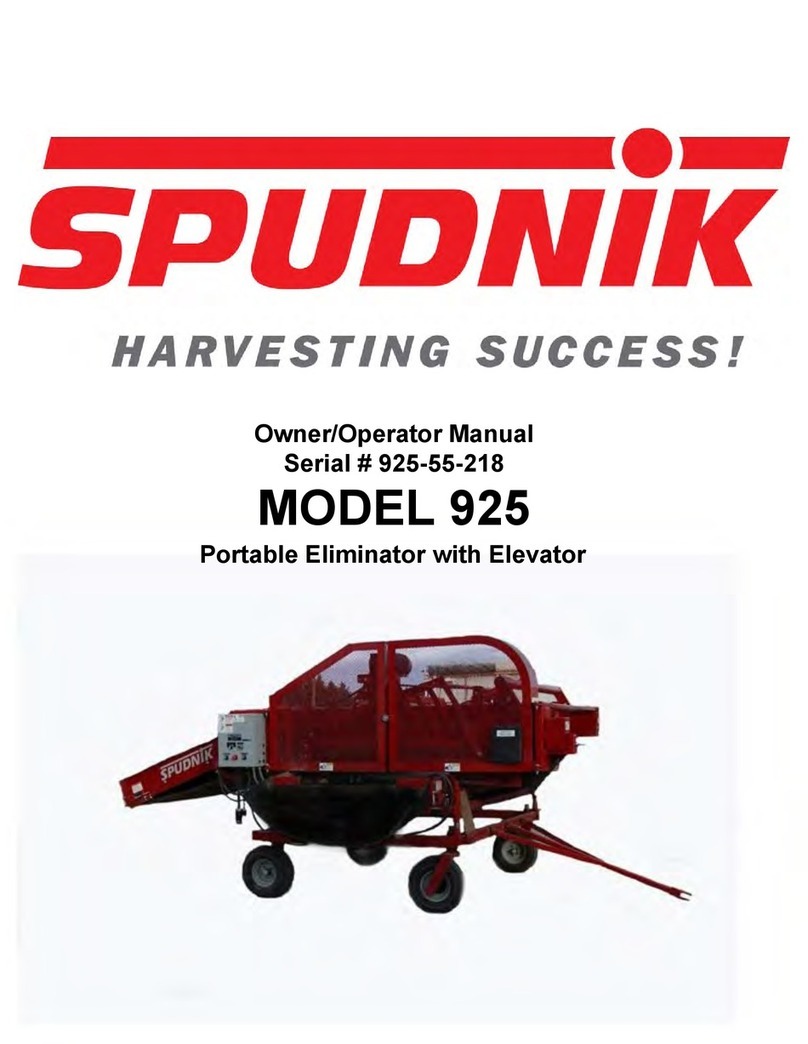
Spudnik
Spudnik 925 Owner's manual
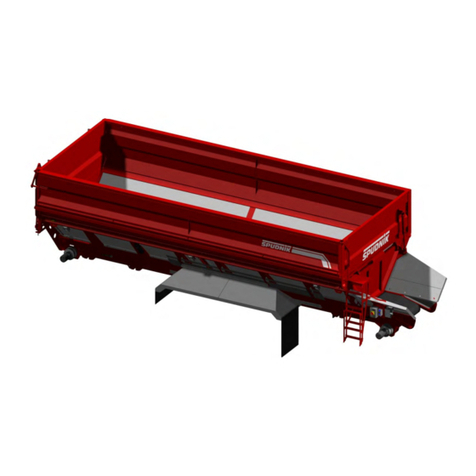
Spudnik
Spudnik 4300 BULK BED User manual
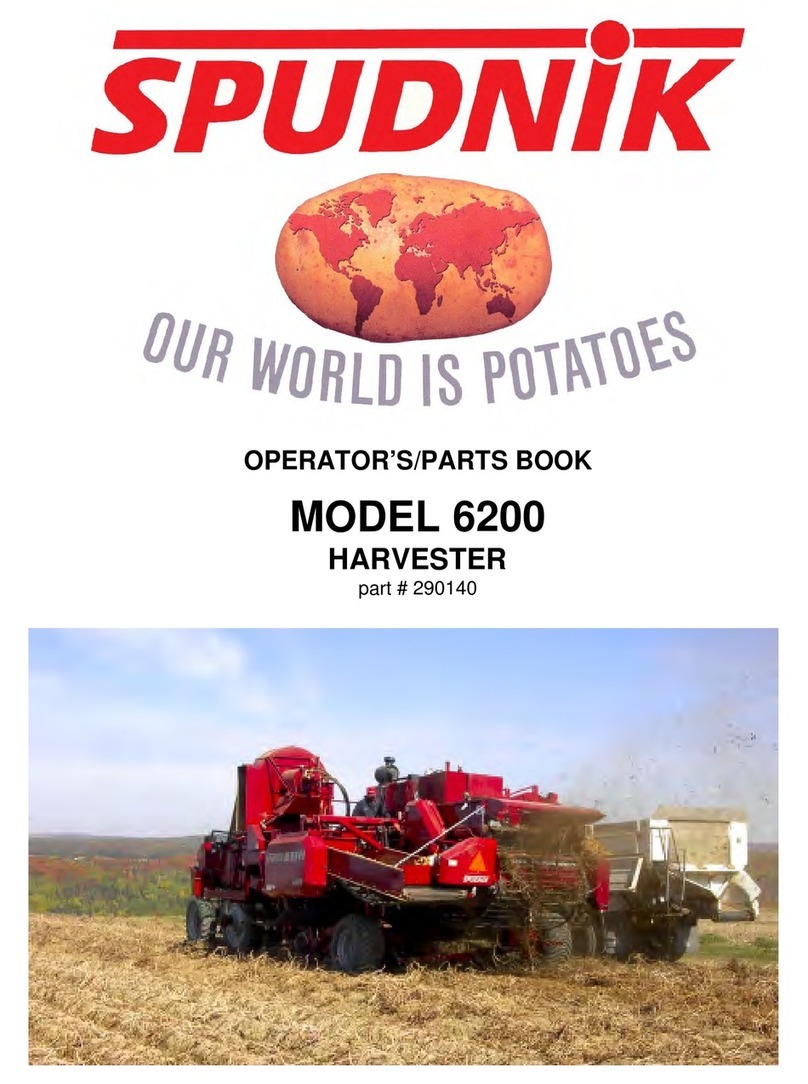
Spudnik
Spudnik 6200 User manual
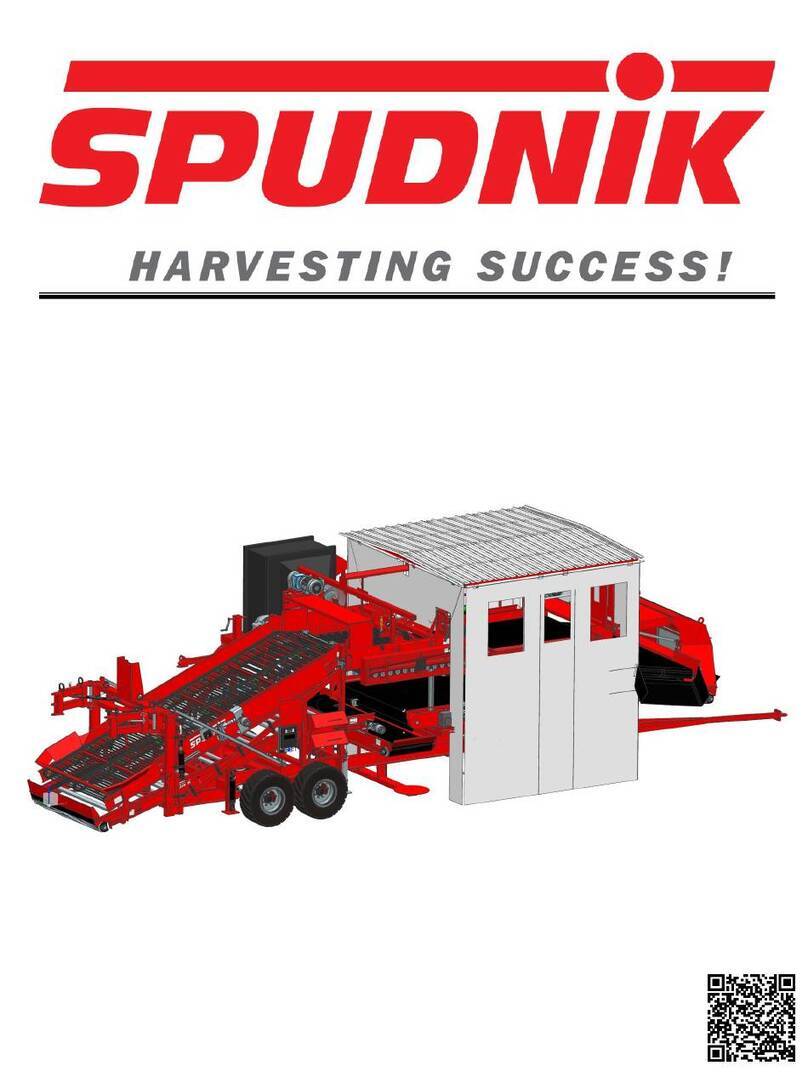
Spudnik
Spudnik 990 User manual
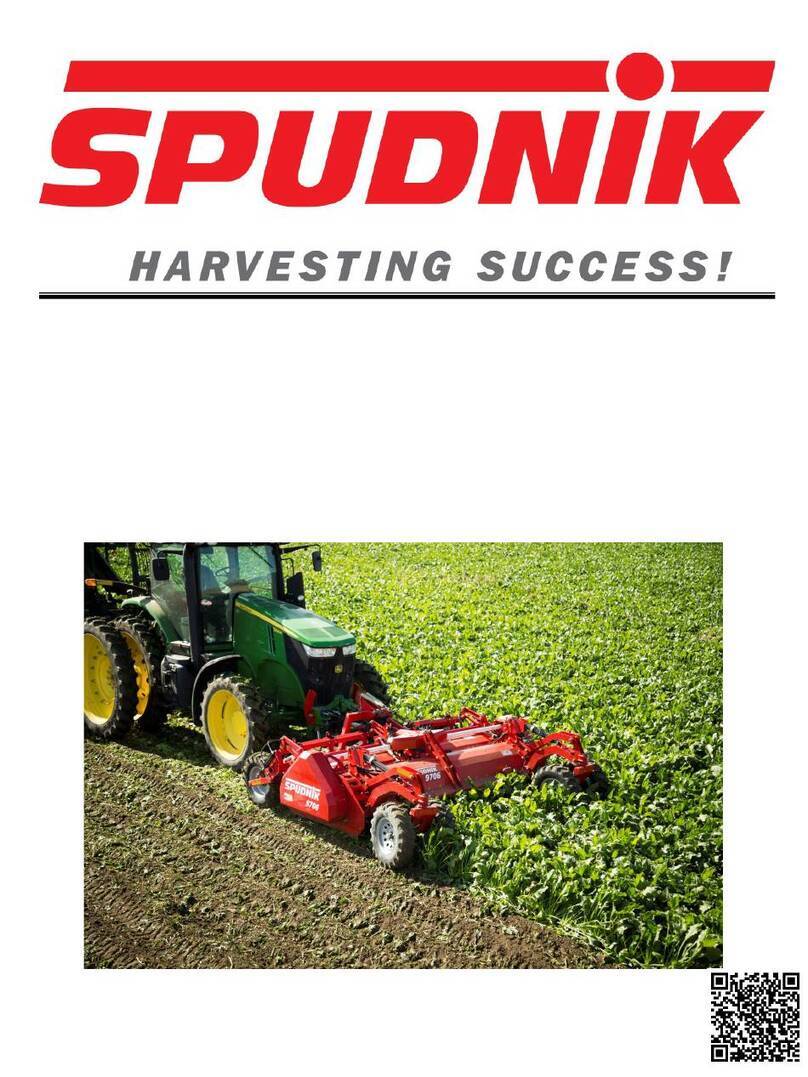
Spudnik
Spudnik 9706 User manual

Spudnik
Spudnik 990 Owner's manual
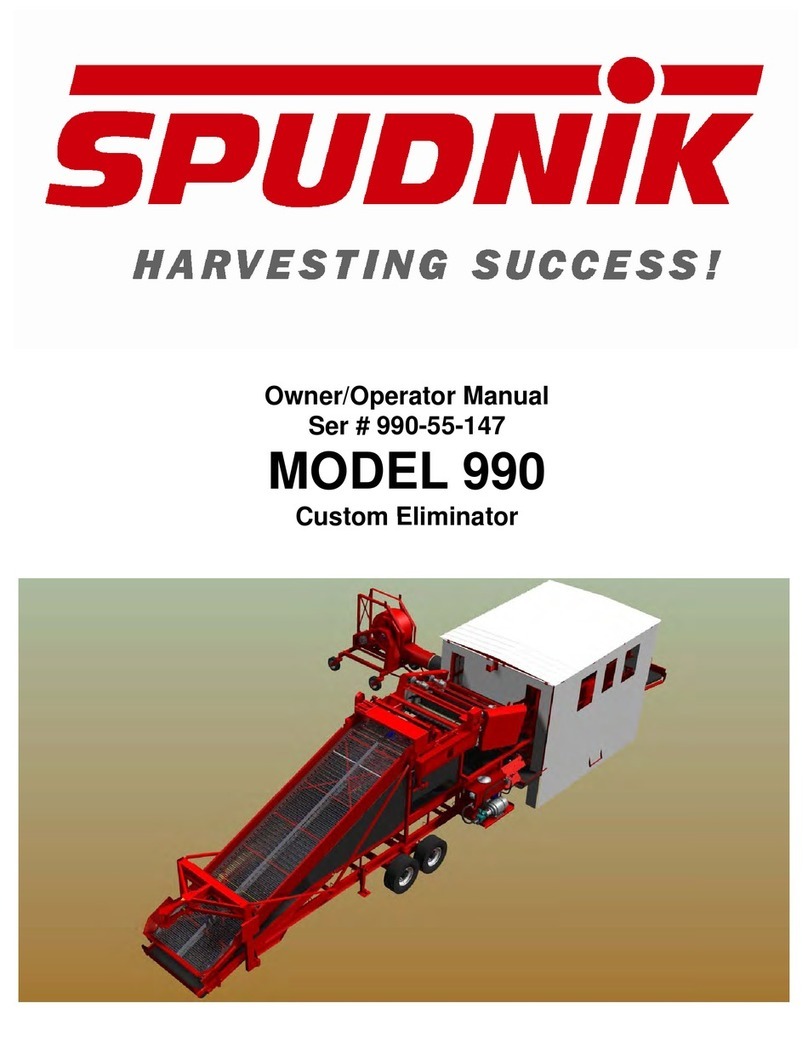
Spudnik
Spudnik 990 Owner's manual
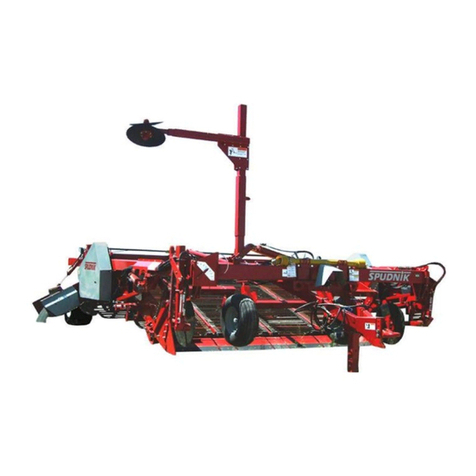
Spudnik
Spudnik 5140 Owner's manual

Spudnik
Spudnik 990 Owner's manual
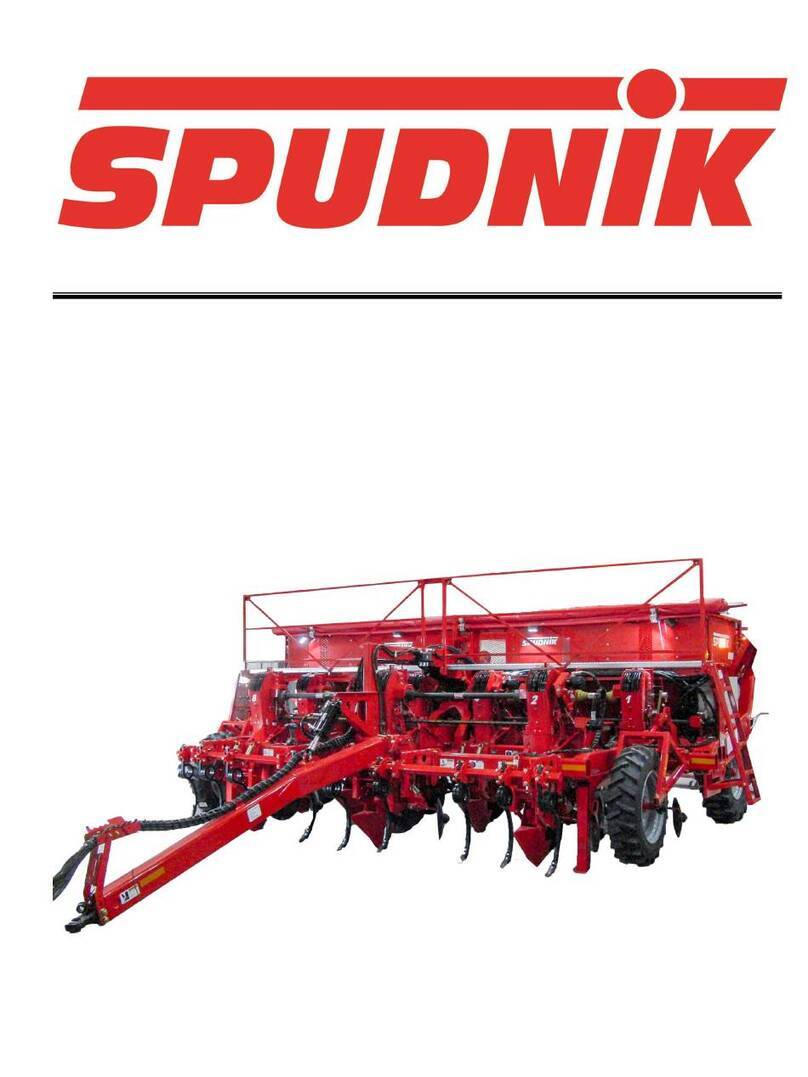
Spudnik
Spudnik 8069 User manual

Spudnik
Spudnik 990 Owner's manual
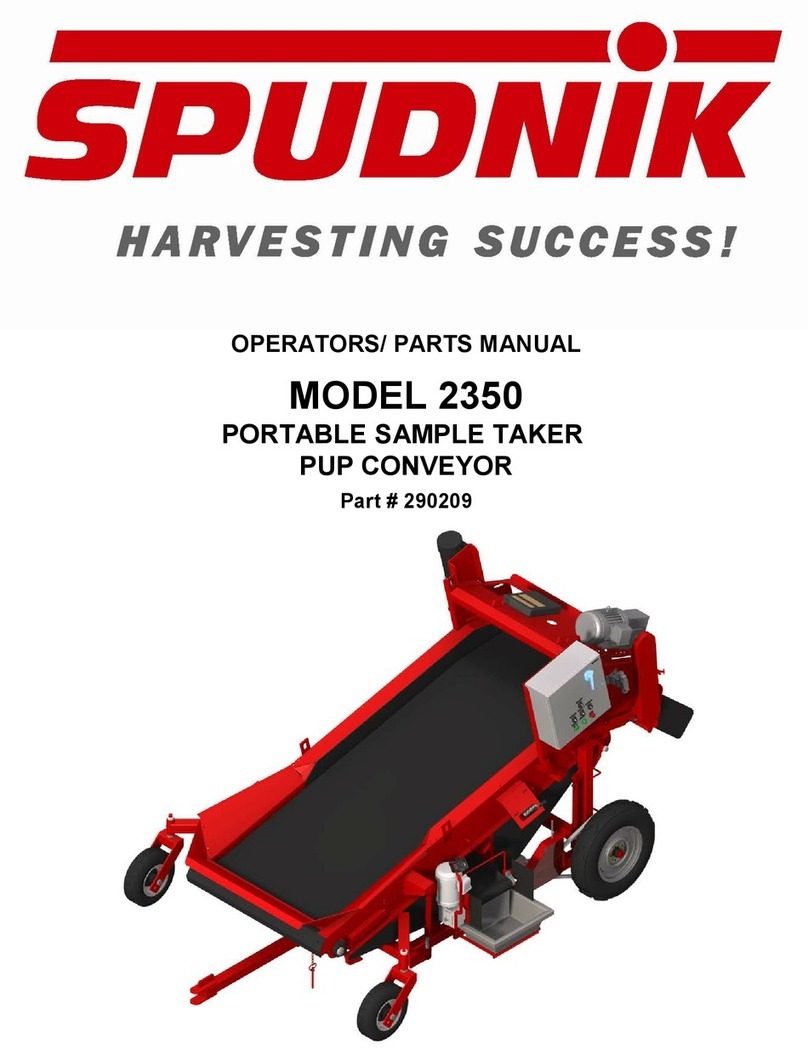
Spudnik
Spudnik 2350 User manual
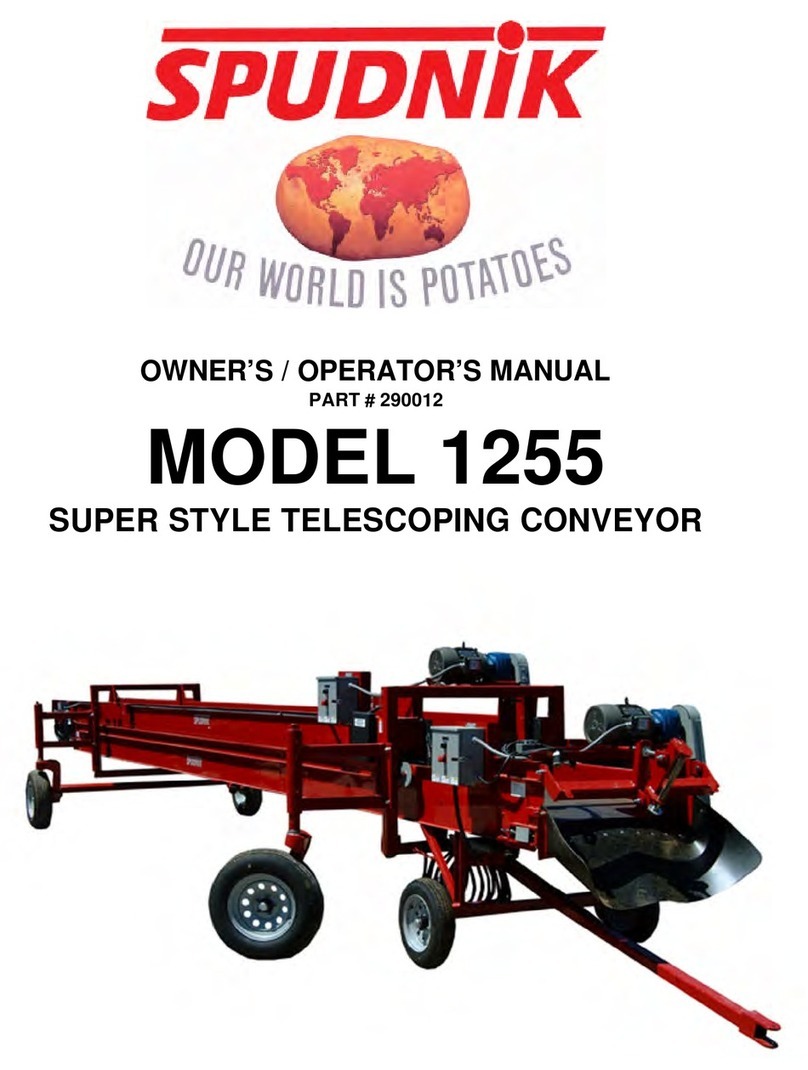
Spudnik
Spudnik 1255 Owner's manual
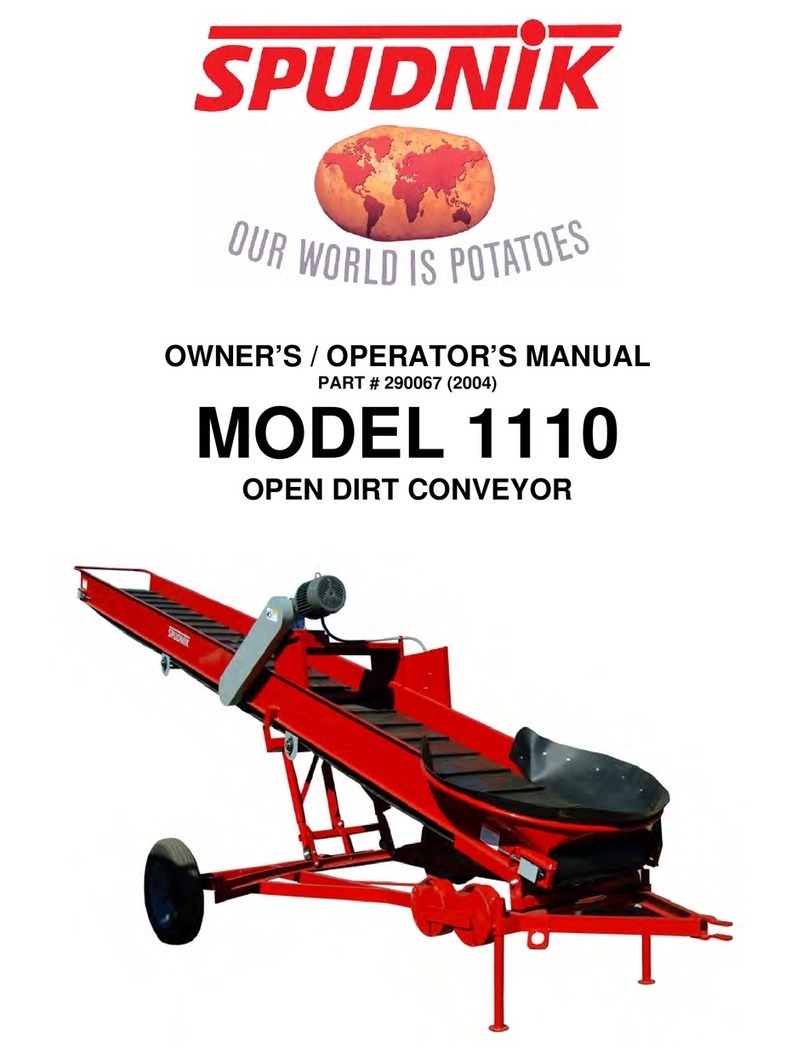
Spudnik
Spudnik 1110 User manual
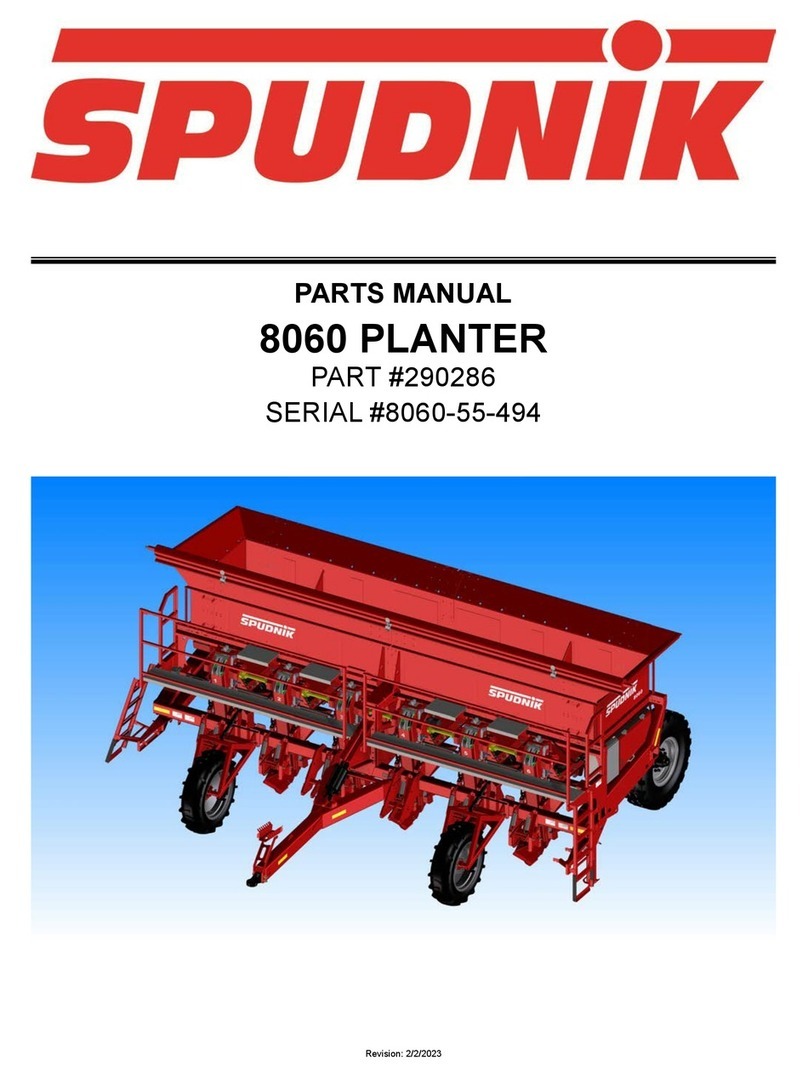
Spudnik
Spudnik 8060 User manual

Spudnik
Spudnik AIRSEP 992 User manual

Spudnik
Spudnik 990 Owner's manual

Spudnik
Spudnik 560 Owner's manual
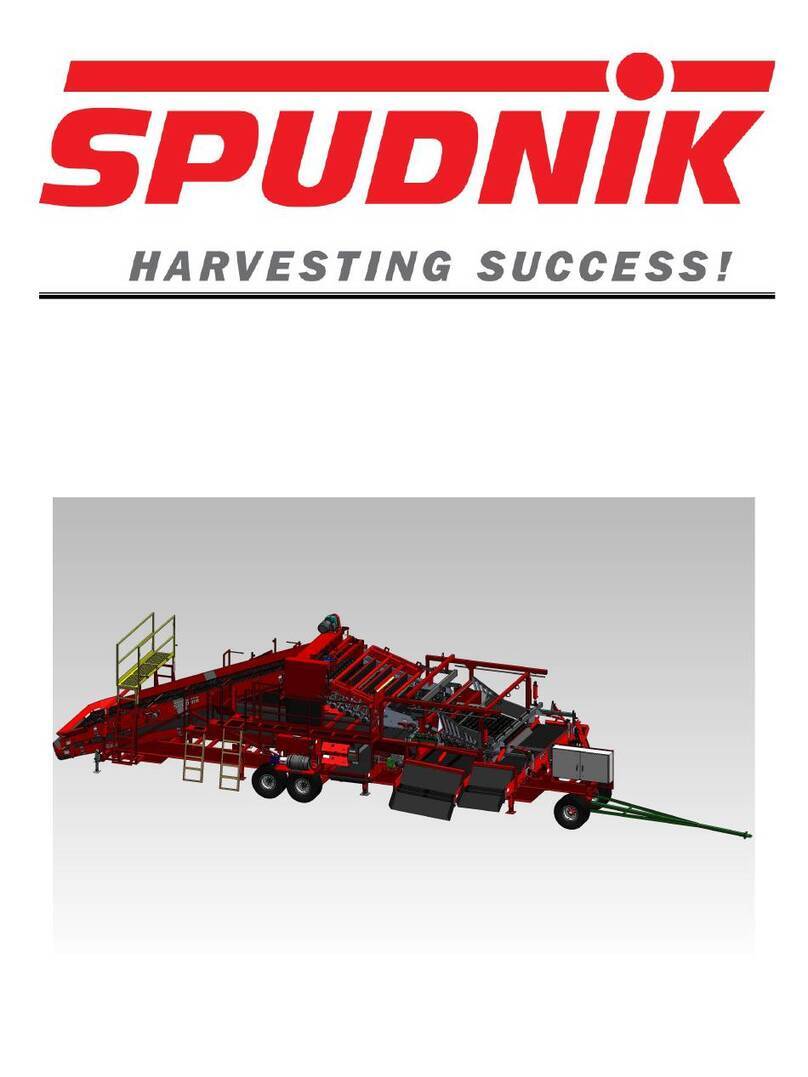
Spudnik
Spudnik 990 User manual

Spudnik
Spudnik 990 User manual
